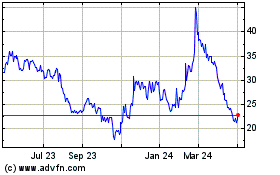false000174599900017459992024-01-082024-01-08
UNITED STATES
SECURITIES AND EXCHANGE COMMISSION
WASHINGTON, D.C. 20549
FORM 8-K
CURRENT REPORT
Pursuant to Section 13 or 15(d) of the Securities Exchange Act of 1934
|
Date of Report (Date of earliest event reported): January 08, 2024 |
Beam Therapeutics Inc.
(Exact name of Registrant as Specified in Its Charter)
|
|
|
|
|
Delaware |
001-39208 |
81-5238376 |
(State or Other Jurisdiction
of Incorporation) |
(Commission File Number) |
(IRS Employer
Identification No.) |
|
|
|
|
|
238 Main Street |
|
Cambridge, Massachusetts |
|
02142 |
(Address of Principal Executive Offices) |
|
(Zip Code) |
|
Registrant’s Telephone Number, Including Area Code: 857 327-8775 |
(Former Name or Former Address, if Changed Since Last Report)
Check the appropriate box below if the Form 8-K filing is intended to simultaneously satisfy the filing obligation of the registrant under any of the following provisions:
☐Written communications pursuant to Rule 425 under the Securities Act (17 CFR 230.425)
☐Soliciting material pursuant to Rule 14a-12 under the Exchange Act (17 CFR 240.14a-12)
☐Pre-commencement communications pursuant to Rule 14d-2(b) under the Exchange Act (17 CFR 240.14d-2(b))
☐Pre-commencement communications pursuant to Rule 13e-4(c) under the Exchange Act (17 CFR 240.13e-4(c))
Securities registered pursuant to Section 12(b) of the Act:
|
|
|
|
|
Title of each class
|
|
Trading
Symbol(s) |
|
Name of each exchange on which registered
|
Common Stock, par value $0.01 per share |
|
BEAM |
|
Nasdaq Global Select Market |
Indicate by check mark whether the registrant is an emerging growth company as defined in Rule 405 of the Securities Act of 1933 (§ 230.405 of this chapter) or Rule 12b-2 of the Securities Exchange Act of 1934 (§ 240.12b-2 of this chapter).
Emerging growth company ☐
If an emerging growth company, indicate by check mark if the registrant has elected not to use the extended transition period for complying with any new or revised financial accounting standards provided pursuant to Section 13(a) of the Exchange Act. ☐
Item 2.02 Results of Operations and Financial Condition.
Although it has not finalized its full financial results for the fourth quarter and fiscal year ended December 31, 2023, Beam Therapeutics Inc. (the “Company”) announced in a press release on January 8, 2024 that it estimates that it had cash, cash equivalents and marketable securities of approximately $1.2 billion as of December 31, 2023.
The information contained in this Item 2.02 regarding the Company’s estimated cash balance as of December 31, 2023 is preliminary, unaudited and is subject to completion of the Company’s financial statement closing procedures. This estimate also does not present all information necessary for an understanding of the Company’s financial condition as of December 31, 2023 and its results of operations for the three months and year ended December 31, 2023. Accordingly, undue reliance should not be placed on this preliminary estimate.
The information in this Item 2.02 is being furnished and shall not be deemed “filed” for purposes of Section 18 of the Securities Exchange Act of 1934, as amended (the “Exchange Act”) or otherwise subject to the liabilities of that section, nor shall it be deemed incorporated by reference in any filing under the Securities Act of 1933, as amended (the “Securities Act”) or the Exchange Act, except as expressly set forth by specific reference in such a filing.
Item 7.01 Regulation FD Disclosure.
On January 8, 2024, the Company updated its corporate presentation that it intends to use in connection with presentations at conferences and meetings, including an investor presentation at the 42nd Annual J.P. Morgan Healthcare Conference on January 8, 2024. The slides from the Company’s corporate presentation are furnished as Exhibit 99.1 to this Current Report on Form 8-K and are incorporated herein by reference.
The information in this Item 7.01 (including Exhibit 99.1 attached hereto) is being furnished and shall not be deemed “filed” for purposes of Section 18 of the Exchange Act or otherwise subject to the liabilities of that section, nor shall it be deemed incorporated by reference into any filing under the Securities Act or the Exchange Act, except as expressly set forth by specific reference in such filling.
Item 8.01 Other Events.
On January 8, 2024, the Company issued a press release announcing progress across its base editing portfolio and outlining key anticipated milestones. The full text of the press release is filed as Exhibit 99.2 to this Current Report on Form 8-K and is incorporated herein by reference. The information contained on the website referenced in the press release is not incorporated herein.
Cautionary Note Regarding Forward-Looking Statements
Statements in this Current Report on Form 8-K about future expectations, plans and prospects, as well as any other statements regarding matters that are not historical facts, may constitute “forward-looking statements” within the meaning of The Private Securities Litigation Reform Act of 1995. These statements include, but are not limited to, statements relating to the Company's upcoming presentations at the 42nd Annual J.P. Morgan Healthcare Conference; the Company's expectations for transitioning to a multi-program clinical stage company; the therapeutic applications and potential of the Company's technology, including with respect to sickle cell disease, glycogen storage disease 1a, relapsed/refractory T-cell acute lymphoblastic leukemia/T-cell lymphoblastic lymphoma, alpha-1 antitrypsin deficiency, and the Company's conditioning regimens; the Company's plans, and anticipated timing, to advance its programs, the clinical trial designs and expectations for BEAM-101, BEAM-201, BEAM-301 and BEAM-302; the Company's estimated cash, cash equivalents and marketable securities as of December 31, 2023 and its expectations related thereto; the sufficiency of the Company's capital resources to fund operating expenses and capital expenditure requirements and the period in which such resources are expected to be available; and the Company's ability to develop life-long, curative, precision genetic medicines for patients through base editing. The words “anticipate,” “believe,” “continue,” “could,” “estimate,” “expect,” “intend,” “may,” “plan,” “potential,” “predict,” “project,” “should,” “target,” “will,” “would” and similar expressions are intended to identify forward-looking statements, although not all forward-looking statements contain these identifying words. Each forward-looking statement is subject to important risks and uncertainties that could cause actual results to differ materially from those expressed or implied in such statement, including, without limitation, risks and uncertainties related to: the Company's ability to successfully achieve the benefits of its portfolio prioritization and strategic restructuring; the Company's ability to develop, obtain regulatory approval for, and commercialize its product candidates, which may take longer or cost more than planned; the Company's ability to raise additional funding, which may not be available; the Company's ability to obtain, maintain and enforce patent and other intellectual property protection for its product candidates; the potential impact of pandemics and other health emergencies, including their impact on the global supply chain; the uncertainty that the Company's product candidates will receive regulatory approval necessary to initiate human clinical studies; that preclinical testing of the Company's product candidates and preliminary or interim data from preclinical studies and clinical trials may not be predictive of the results or success of ongoing or later clinical trials; that initiation and enrollment of, and anticipated timing to advance, the Company's clinical trials may take longer than expected; that the Company's product candidates may experience manufacturing or supply interruptions or failures; risks related to competitive products;
whether the Company's actual audited results will be consistent with its estimated cash, cash equivalents and marketable securities as of December 31, 2023; and the other risks and uncertainties identified under the headings “Risk Factors” and “Risk Factors Summary” in the Company's Annual Report on Form 10-K for the year ended December 31, 2022, its Quarterly Report on Form 10-Q for the quarter ended March 31, 2023, its Quarterly Report on Form 10-Q for the quarter ended June 30, 2023, its Quarterly Report on Form 10-Q for the quarter ended September 30, 2023, and in any subsequent filings with the Securities and Exchange Commission. These forward-looking statements speak only as of the date of this Current Report on Form 8-K. Factors or events that could cause the Company's actual results to differ may emerge from time to time, and it is not possible for the Company to predict all of them. The Company undertakes no obligation to update any forward-looking statement, whether as a result of new information, future developments or otherwise, except as may be required by applicable law.
Item 9.01 Financial Statements and Exhibits.
(d) Exhibits
SIGNATURES
Pursuant to the requirements of the Securities Exchange Act of 1934, the registrant has duly caused this report to be signed on its behalf by the undersigned hereunto duly authorized.
|
|
|
|
|
|
|
BEAM THERAPEUTICS INC. |
|
|
|
|
Date: |
January 8, 2024 |
By: |
/s/ John Evans |
|
|
|
John Evans
Chief Executive Officer |
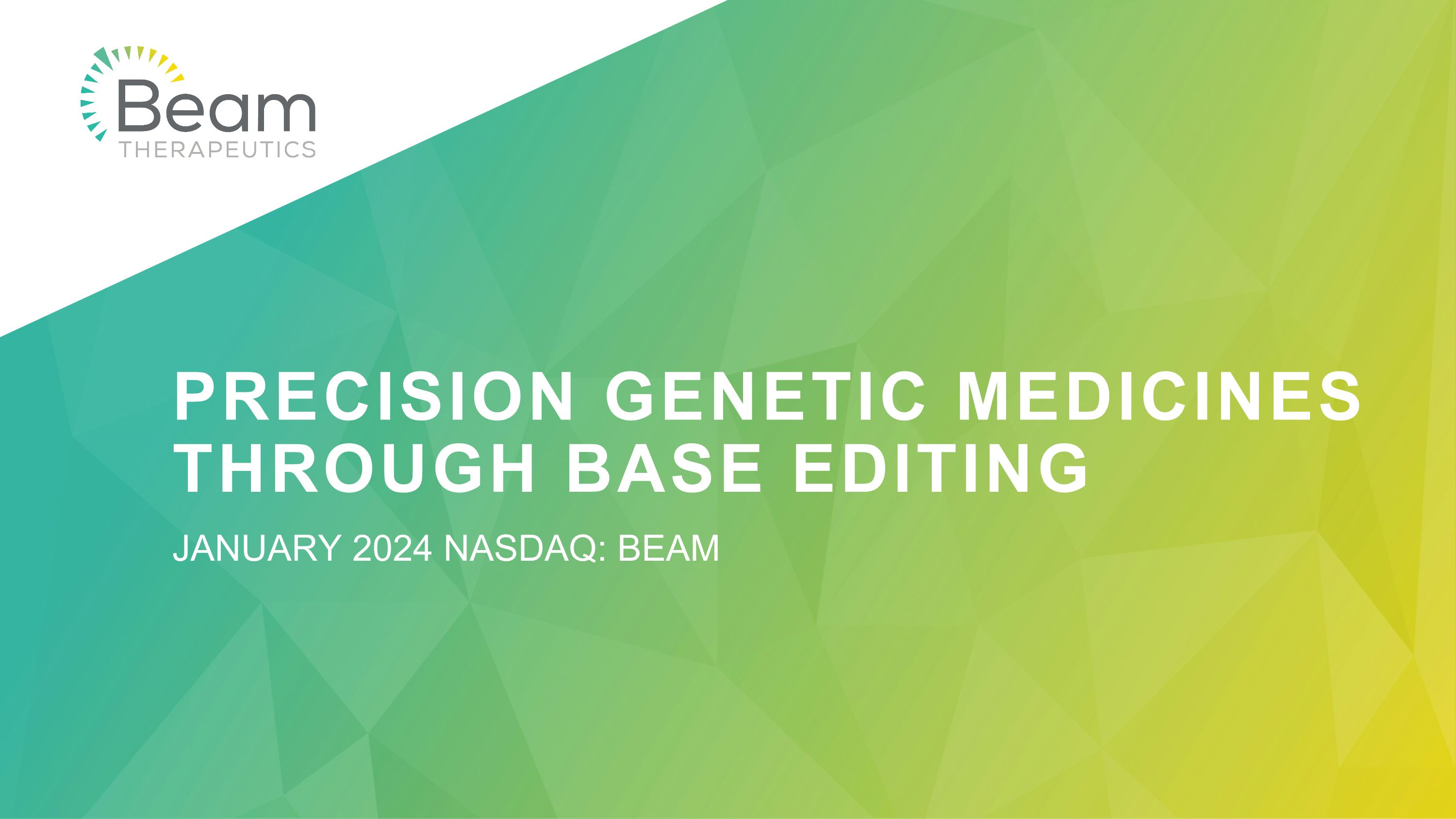
PRECISION GENETIC MEDICINES �THROUGH BASE EDITING JANUARY 2024 NASDAQ: BEAM
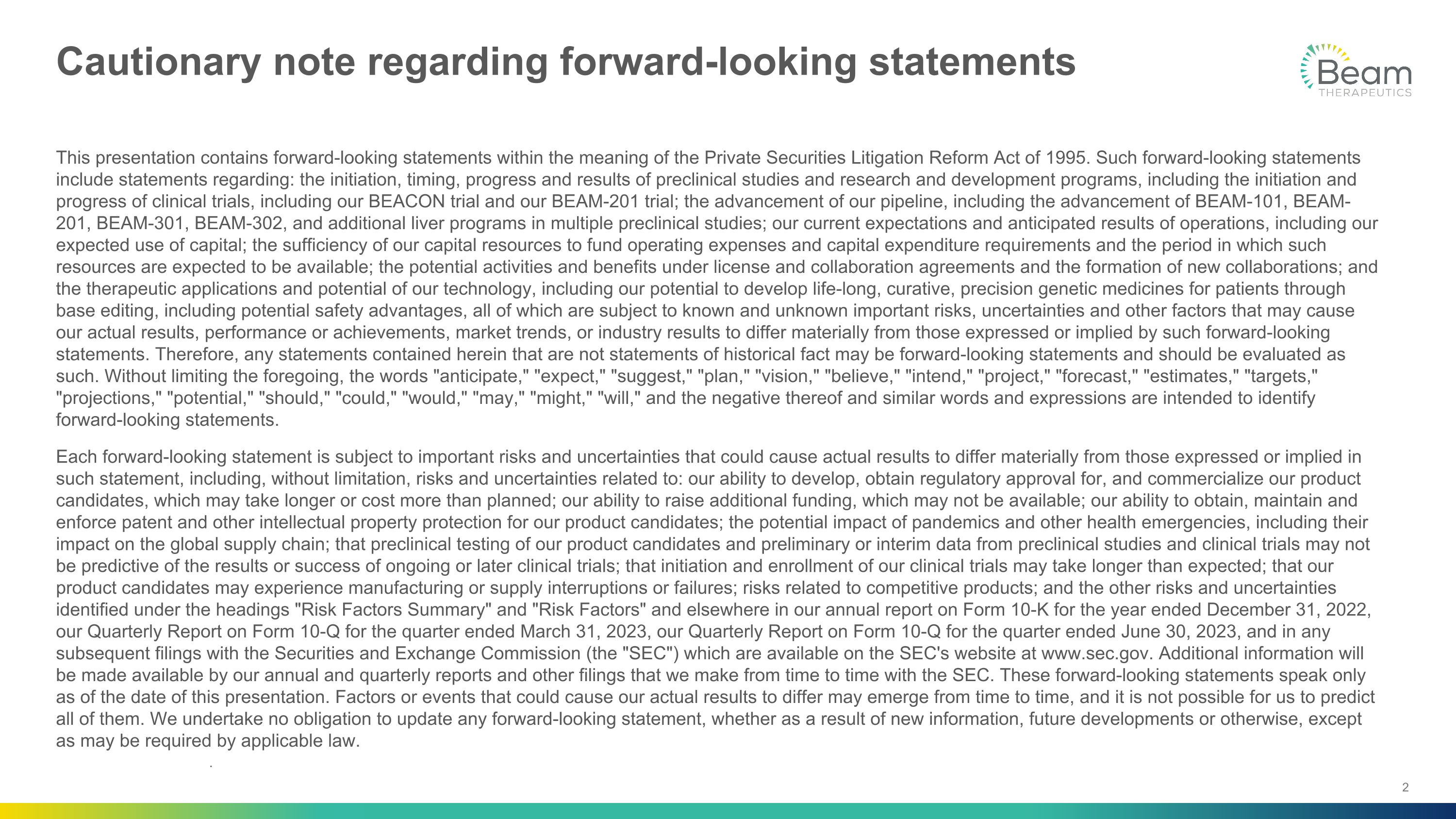
Cautionary note regarding forward-looking statements This presentation contains forward-looking statements within the meaning of the Private Securities Litigation Reform Act of 1995. Such forward-looking statements include statements regarding: the initiation, timing, progress and results of preclinical studies and research and development programs, including the initiation and progress of clinical trials, including our BEACON trial and our BEAM-201 trial; the advancement of our pipeline, including the advancement of BEAM-101, BEAM-201, BEAM-301, BEAM-302, and additional liver programs in multiple preclinical studies; our current expectations and anticipated results of operations, including our expected use of capital; the sufficiency of our capital resources to fund operating expenses and capital expenditure requirements and the period in which such resources are expected to be available; the potential activities and benefits under license and collaboration agreements and the formation of new collaborations; and the therapeutic applications and potential of our technology, including our potential to develop life-long, curative, precision genetic medicines for patients through base editing, including potential safety advantages, all of which are subject to known and unknown important risks, uncertainties and other factors that may cause our actual results, performance or achievements, market trends, or industry results to differ materially from those expressed or implied by such forward-looking statements. Therefore, any statements contained herein that are not statements of historical fact may be forward-looking statements and should be evaluated as such. Without limiting the foregoing, the words "anticipate," "expect," "suggest," "plan," "vision," "believe," "intend," "project," "forecast," "estimates," "targets," "projections," "potential," "should," "could," "would," "may," "might," "will," and the negative thereof and similar words and expressions are intended to identify forward-looking statements. Each forward-looking statement is subject to important risks and uncertainties that could cause actual results to differ materially from those expressed or implied in such statement, including, without limitation, risks and uncertainties related to: our ability to develop, obtain regulatory approval for, and commercialize our product candidates, which may take longer or cost more than planned; our ability to raise additional funding, which may not be available; our ability to obtain, maintain and enforce patent and other intellectual property protection for our product candidates; the potential impact of pandemics and other health emergencies, including their impact on the global supply chain; that preclinical testing of our product candidates and preliminary or interim data from preclinical studies and clinical trials may not be predictive of the results or success of ongoing or later clinical trials; that initiation and enrollment of our clinical trials may take longer than expected; that our product candidates may experience manufacturing or supply interruptions or failures; risks related to competitive products; and the other risks and uncertainties identified under the headings "Risk Factors Summary" and "Risk Factors" and elsewhere in our annual report on Form 10-K for the year ended December 31, 2022, our Quarterly Report on Form 10-Q for the quarter ended March 31, 2023, our Quarterly Report on Form 10-Q for the quarter ended June 30, 2023, and in any subsequent filings with the Securities and Exchange Commission (the "SEC") which are available on the SEC's website at www.sec.gov. Additional information will be made available by our annual and quarterly reports and other filings that we make from time to time with the SEC. These forward-looking statements speak only as of the date of this presentation. Factors or events that could cause our actual results to differ may emerge from time to time, and it is not possible for us to predict all of them. We undertake no obligation to update any forward-looking statement, whether as a result of new information, future developments or otherwise, except as may be required by applicable law. .
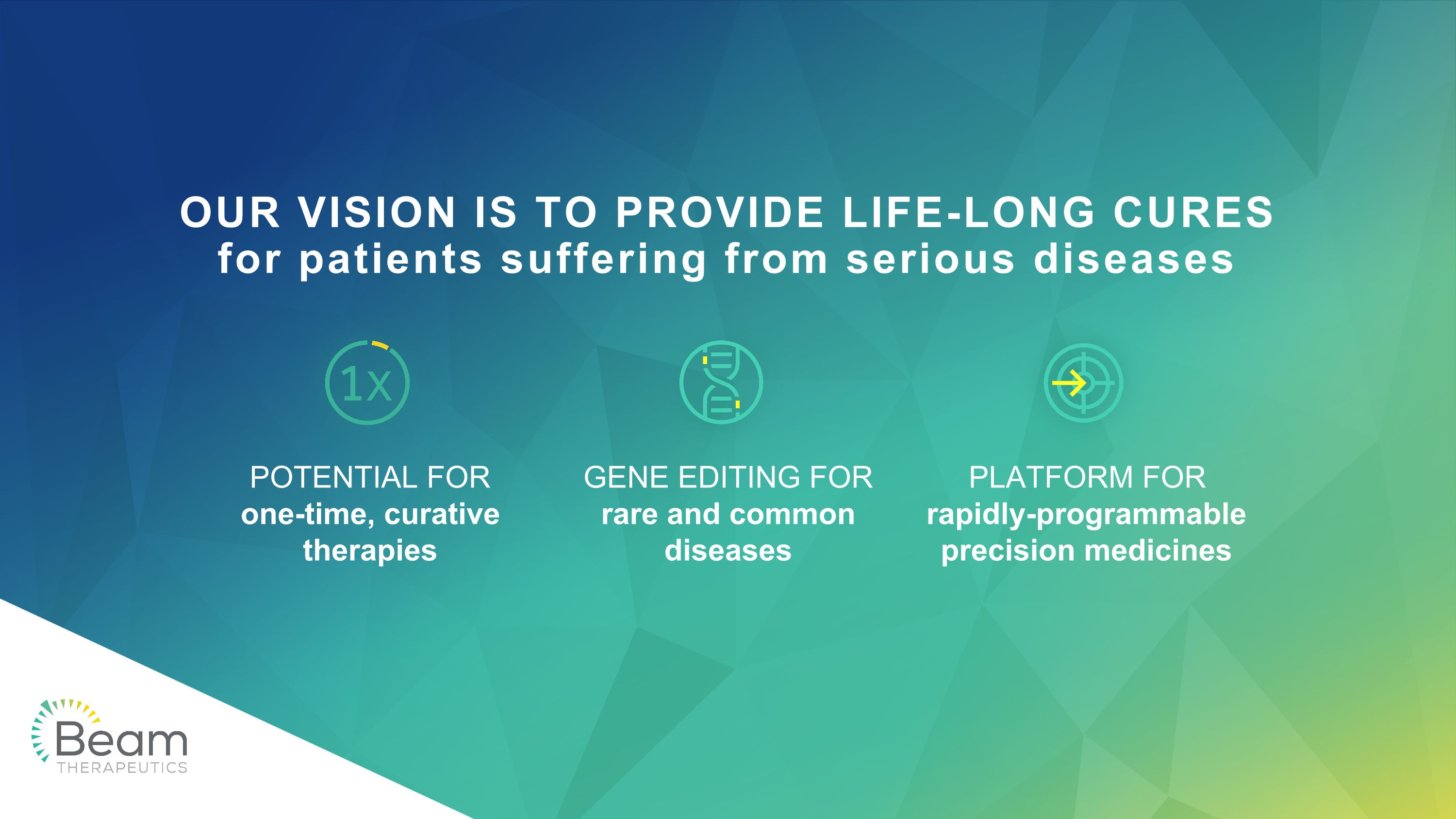
OUR VISION IS TO PROVIDE LIFE-LONG CURES �for patients suffering from serious diseases POTENTIAL FOR �one-time, curative therapies GENE EDITING FOR �rare and common diseases PLATFORM FOR �rapidly-programmable precision medicines
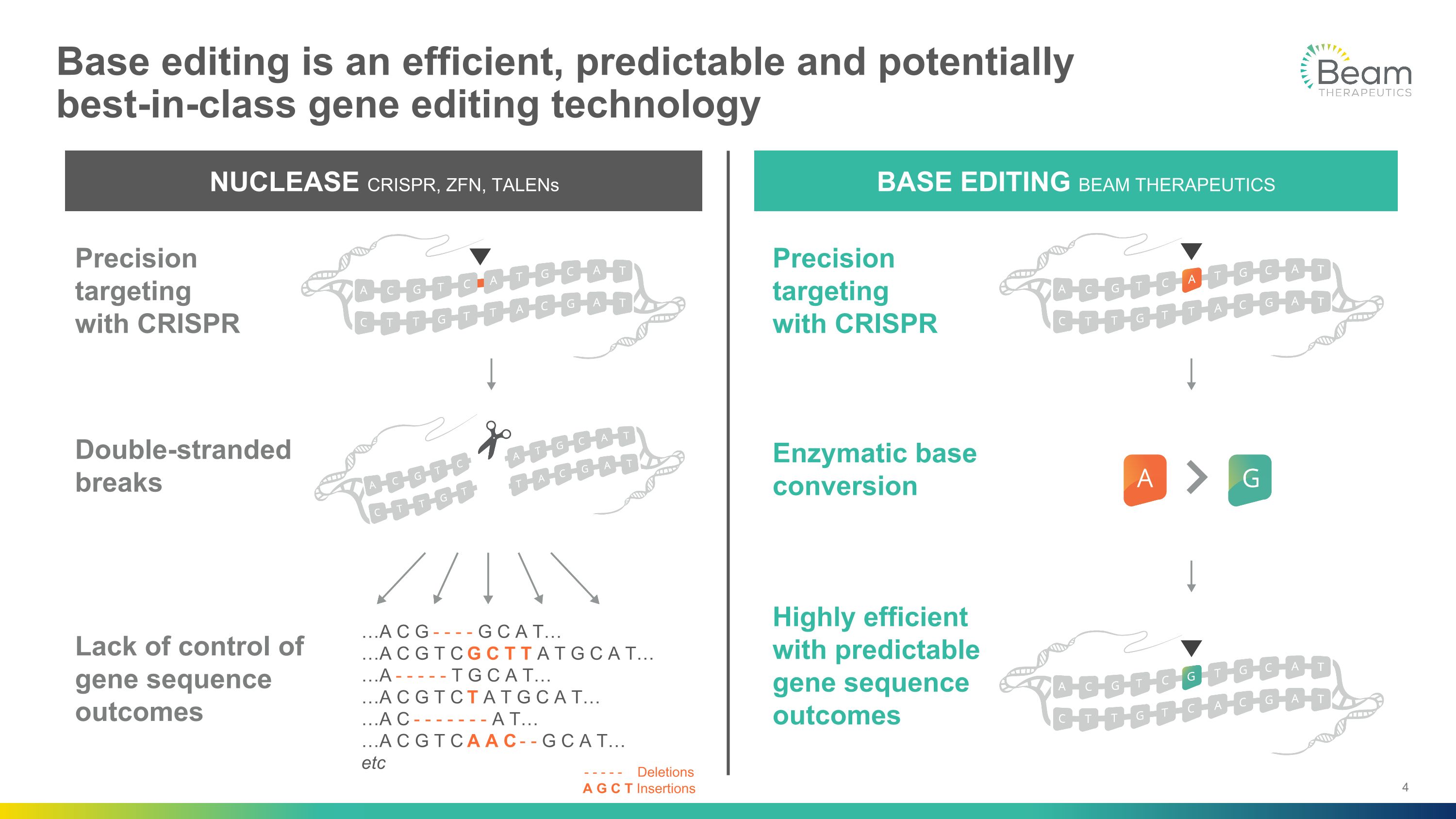
Base editing is an efficient, predictable and potentially�best-in-class gene editing technology NUCLEASE CRISPR, ZFN, TALENs Double-stranded breaks Lack of control of gene sequence outcomes Precision targeting�with CRISPR BASE EDITING BEAM THERAPEUTICS Enzymatic base conversion Highly efficient with predictable gene sequence outcomes Precision targeting�with CRISPR …A C G - - - - G C A T… …A C G T C G C T T A T G C A T… …A - - - - - T G C A T… …A C G T C T A T G C A T… …A C - - - - - - - A T… …A C G T C A A C - - G C A T… etc - - - - - Deletions A G C T Insertions
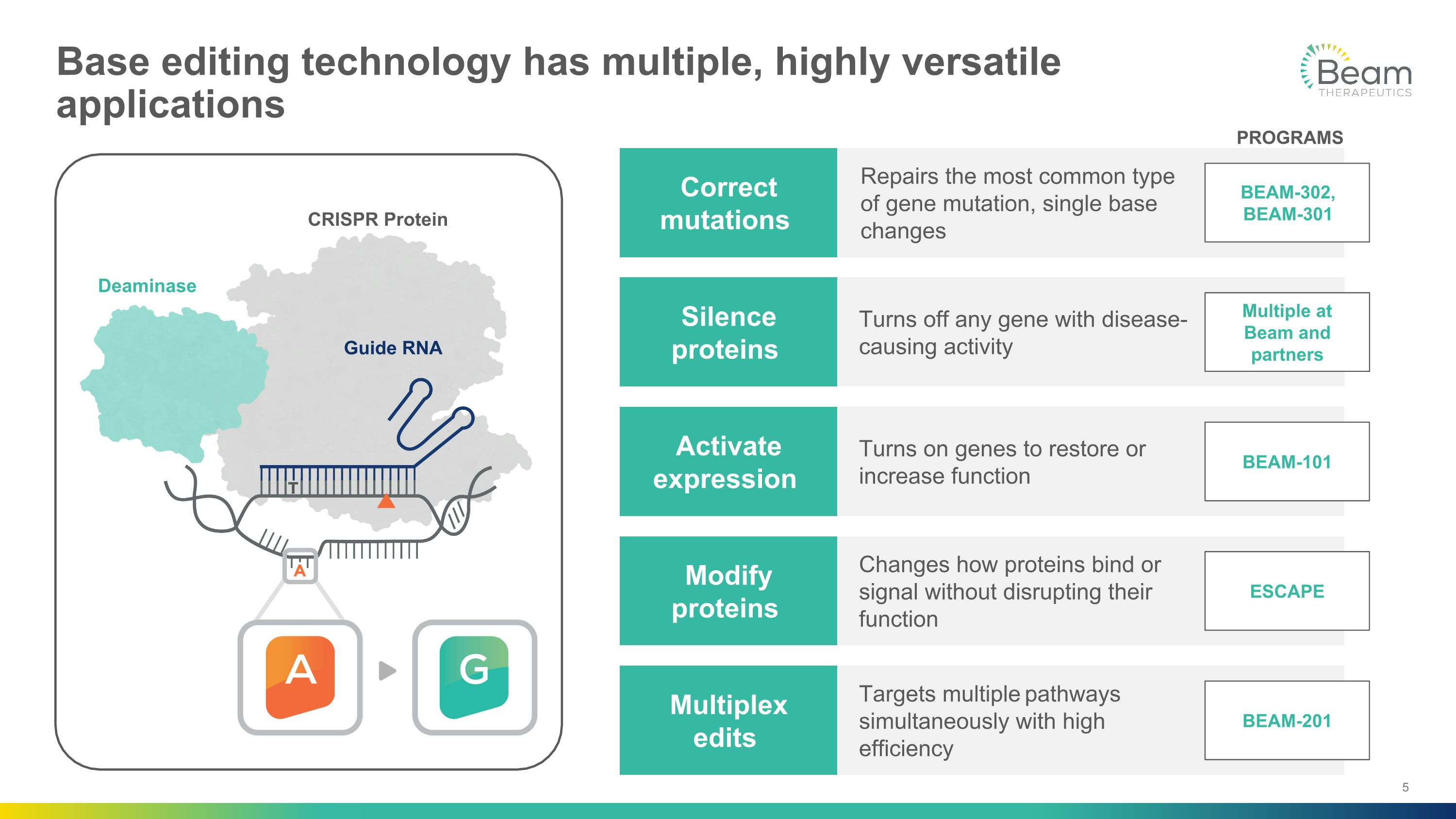
Base editing technology has multiple, highly versatile applications CRISPR Protein Deaminase Guide RNA Activate expression Silence proteins Correct mutations Multiplex edits Modify proteins Turns on genes to restore or increase function Turns off any gene with disease-causing activity Repairs the most common type �of gene mutation, single base changes Targets multiple pathways simultaneously with high efficiency Changes how proteins bind or signal without disrupting their function BEAM-101 Multiple at Beam and partners BEAM-302, BEAM-301 BEAM-201 ESCAPE PROGRAMS
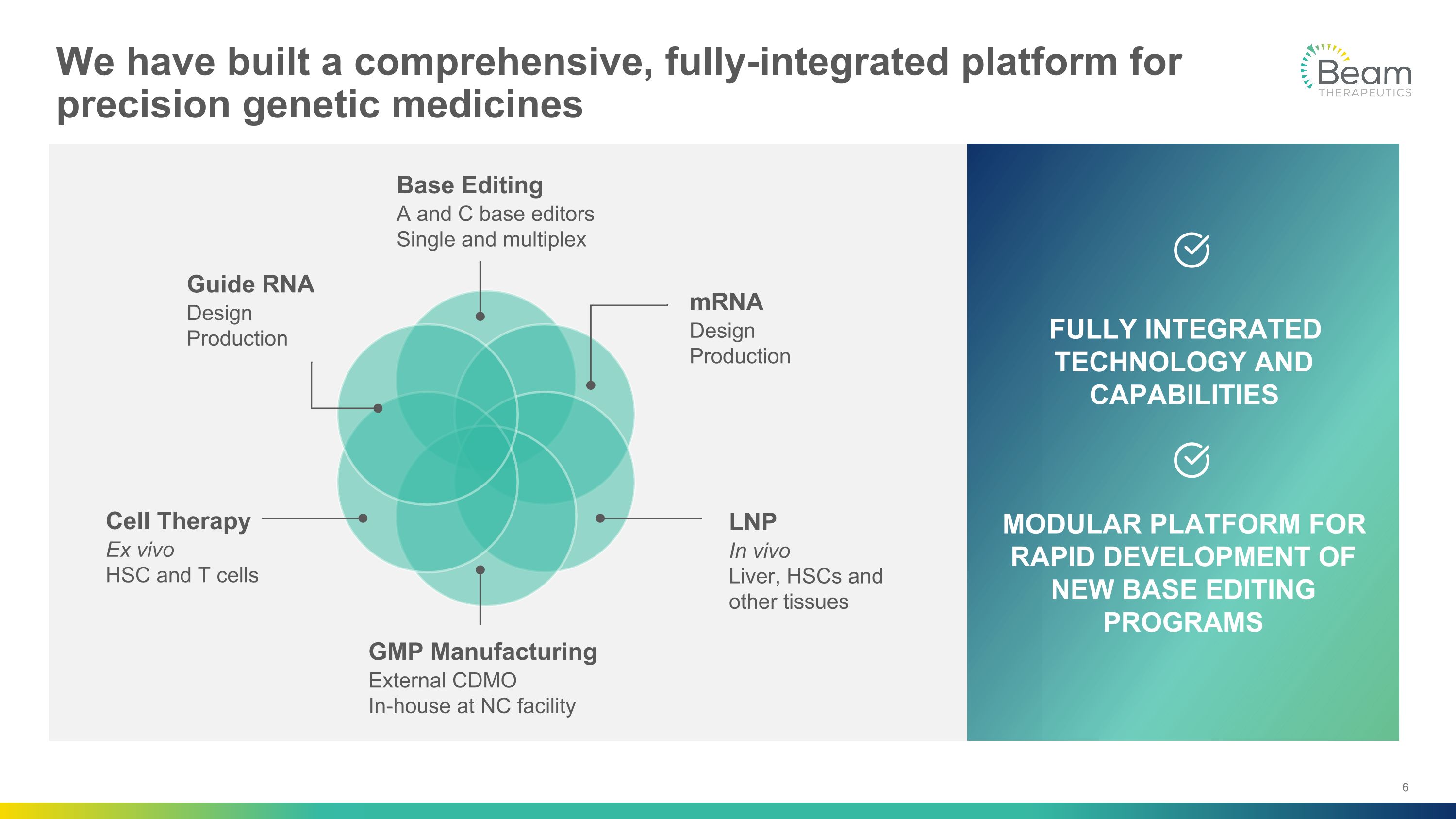
We have built a comprehensive, fully-integrated platform for precision genetic medicines Guide RNA Design Production Base Editing A and C base editors Single and multiplex mRNA Design Production Cell Therapy Ex vivo HSC and T cells LNP In vivo Liver, HSCs and other tissues GMP Manufacturing External CDMO In-house at NC facility FULLY INTEGRATED TECHNOLOGY AND CAPABILITIES MODULAR PLATFORM FOR RAPID DEVELOPMENT OF NEW BASE EDITING PROGRAMS
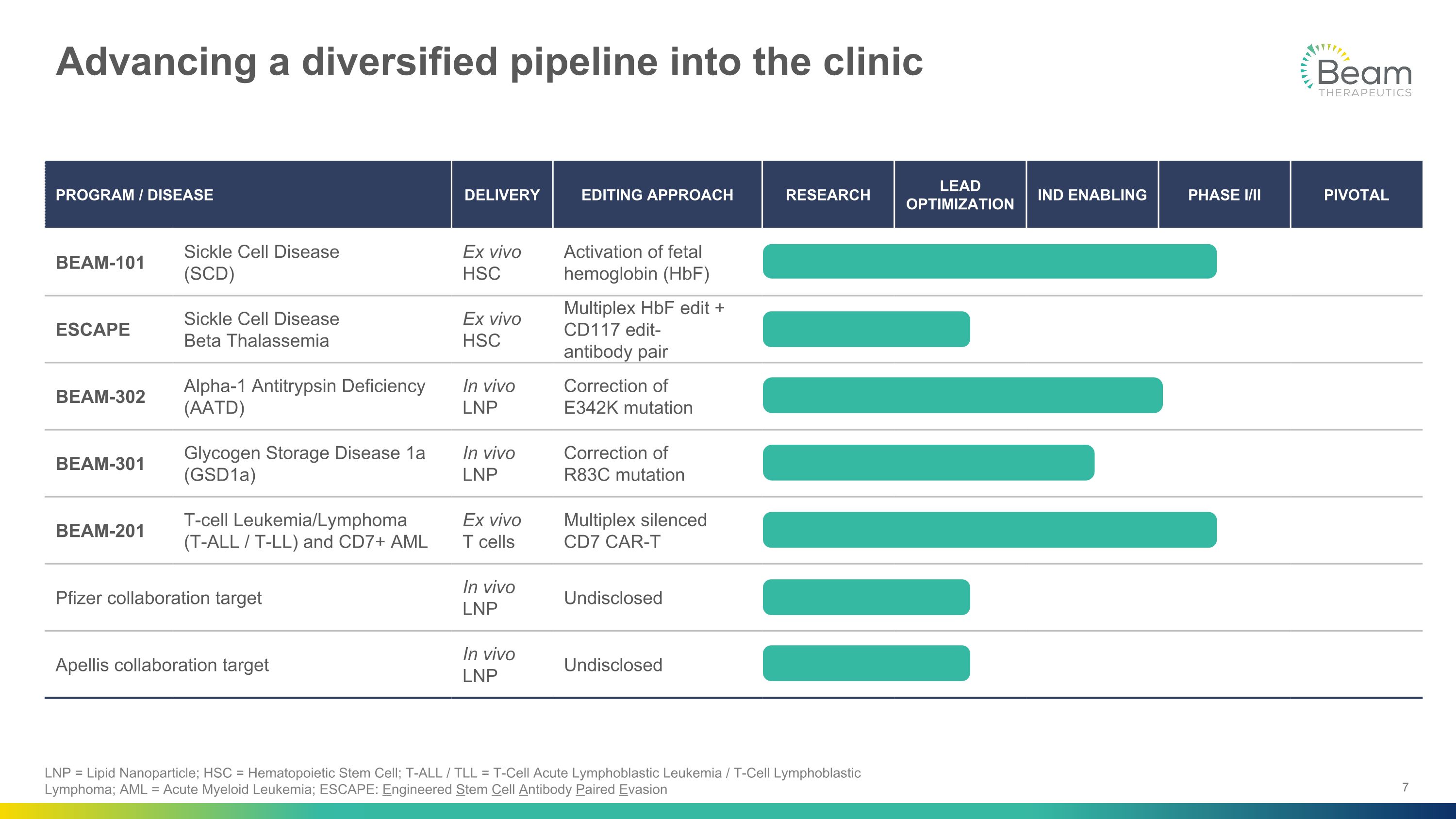
Advancing a diversified pipeline into the clinic PROGRAM / DISEASE DELIVERY EDITING APPROACH RESEARCH LEAD OPTIMIZATION IND ENABLING PHASE I/II PIVOTAL BEAM-101 Sickle Cell Disease�(SCD) Ex vivo HSC Activation of fetal hemoglobin (HbF) ESCAPE Sickle Cell Disease Beta Thalassemia Ex vivo HSC Multiplex HbF edit +�CD117 edit- antibody pair BEAM-302 Alpha-1 Antitrypsin Deficiency (AATD) In vivo LNP Correction of �E342K mutation BEAM-301 Glycogen Storage Disease 1a (GSD1a) In vivo LNP Correction of �R83C mutation BEAM-201 T-cell Leukemia/Lymphoma (T-ALL / T-LL) and CD7+ AML Ex vivo T cells Multiplex silenced �CD7 CAR-T Pfizer collaboration target In vivo LNP Undisclosed Apellis collaboration target In vivo LNP Undisclosed LNP = Lipid Nanoparticle; HSC = Hematopoietic Stem Cell; T-ALL / TLL = T-Cell Acute Lymphoblastic Leukemia / T-Cell Lymphoblastic Lymphoma; AML = Acute Myeloid Leukemia; ESCAPE: Engineered Stem Cell Antibody Paired Evasion
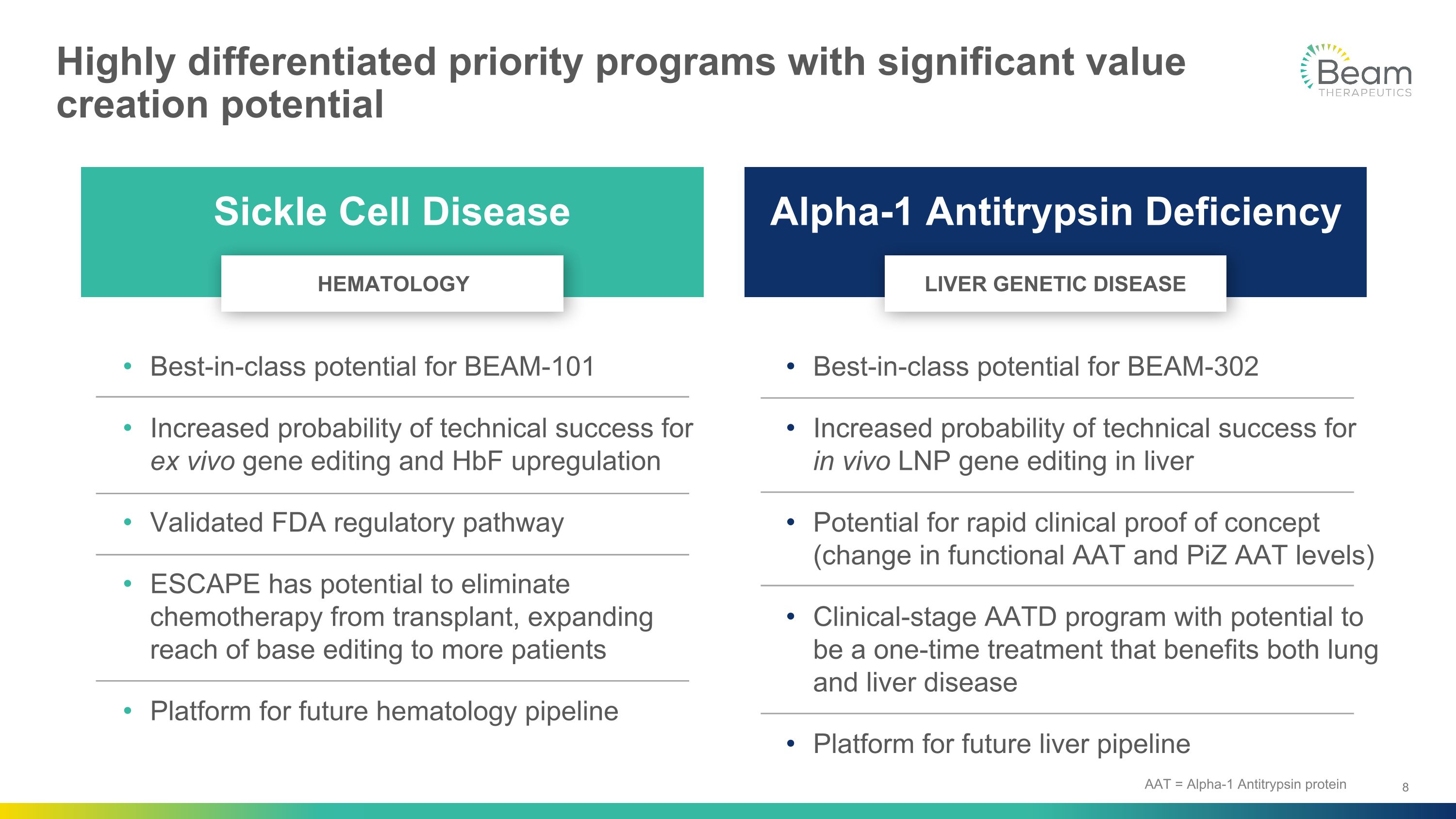
Highly differentiated priority programs with significant value creation potential Sickle Cell Disease Alpha-1 Antitrypsin Deficiency Best-in-class potential for BEAM-101 Increased probability of technical success for ex vivo gene editing and HbF upregulation Validated FDA regulatory pathway ESCAPE has potential to eliminate chemotherapy from transplant, expanding reach of base editing to more patients Platform for future hematology pipeline Best-in-class potential for BEAM-302 Increased probability of technical success for�in vivo LNP gene editing in liver Potential for rapid clinical proof of concept (change in functional AAT and PiZ AAT levels) Clinical-stage AATD program with potential to be a one-time treatment that benefits both lung and liver disease Platform for future liver pipeline HEMATOLOGY LIVER GENETIC DISEASE AAT = Alpha-1 Antitrypsin protein
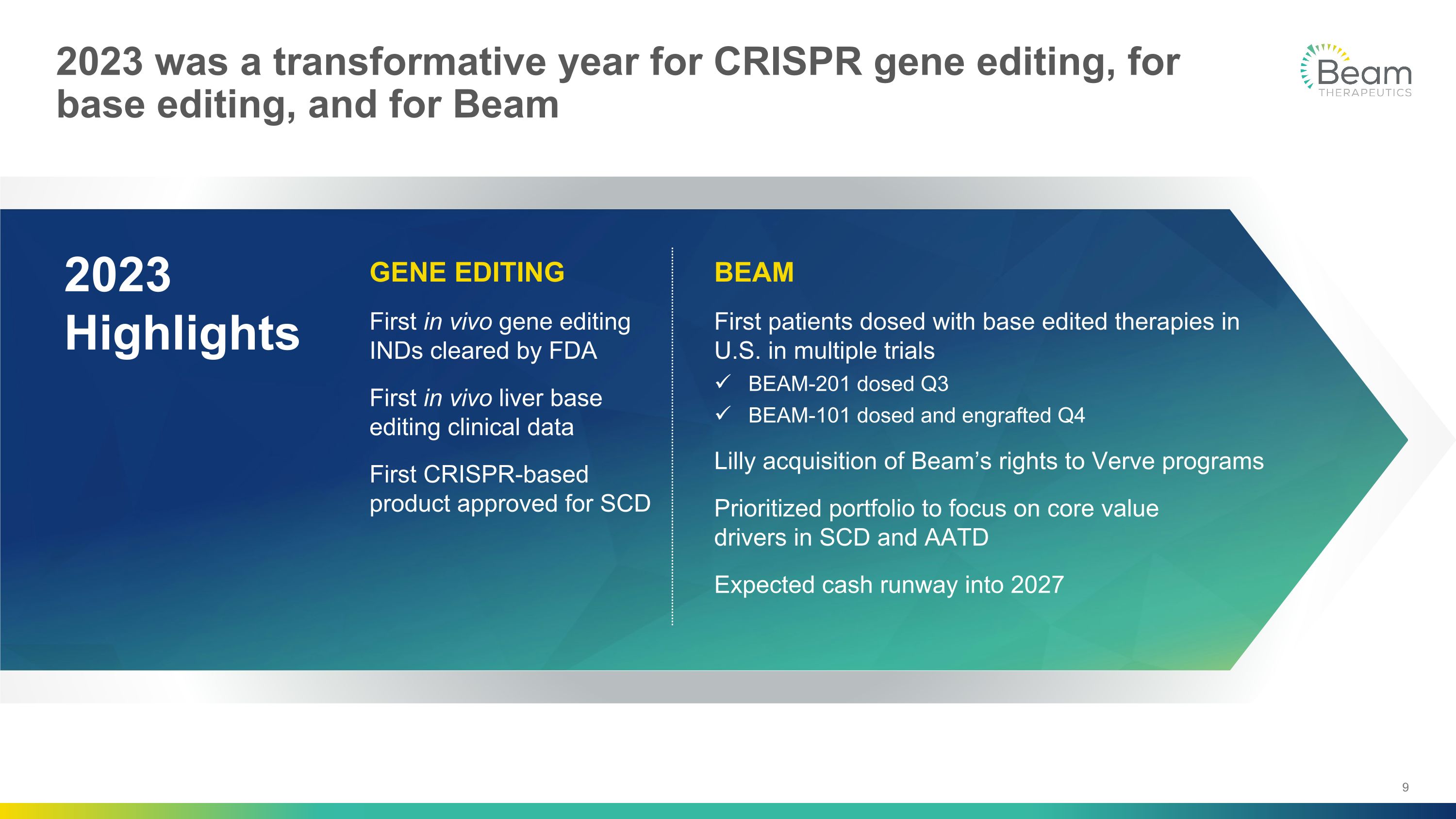
2023 was a transformative year for CRISPR gene editing, for base editing, and for Beam 2023 Highlights GENE EDITING First in vivo gene editing INDs cleared by FDA First in vivo liver base editing clinical data First CRISPR-based product approved for SCD BEAM First patients dosed with base edited therapies in �U.S. in multiple trials BEAM-201 dosed Q3 BEAM-101 dosed and engrafted Q4 Lilly acquisition of Beam’s rights to Verve programs Prioritized portfolio to focus on core value �drivers in SCD and AATD Expected cash runway into 2027
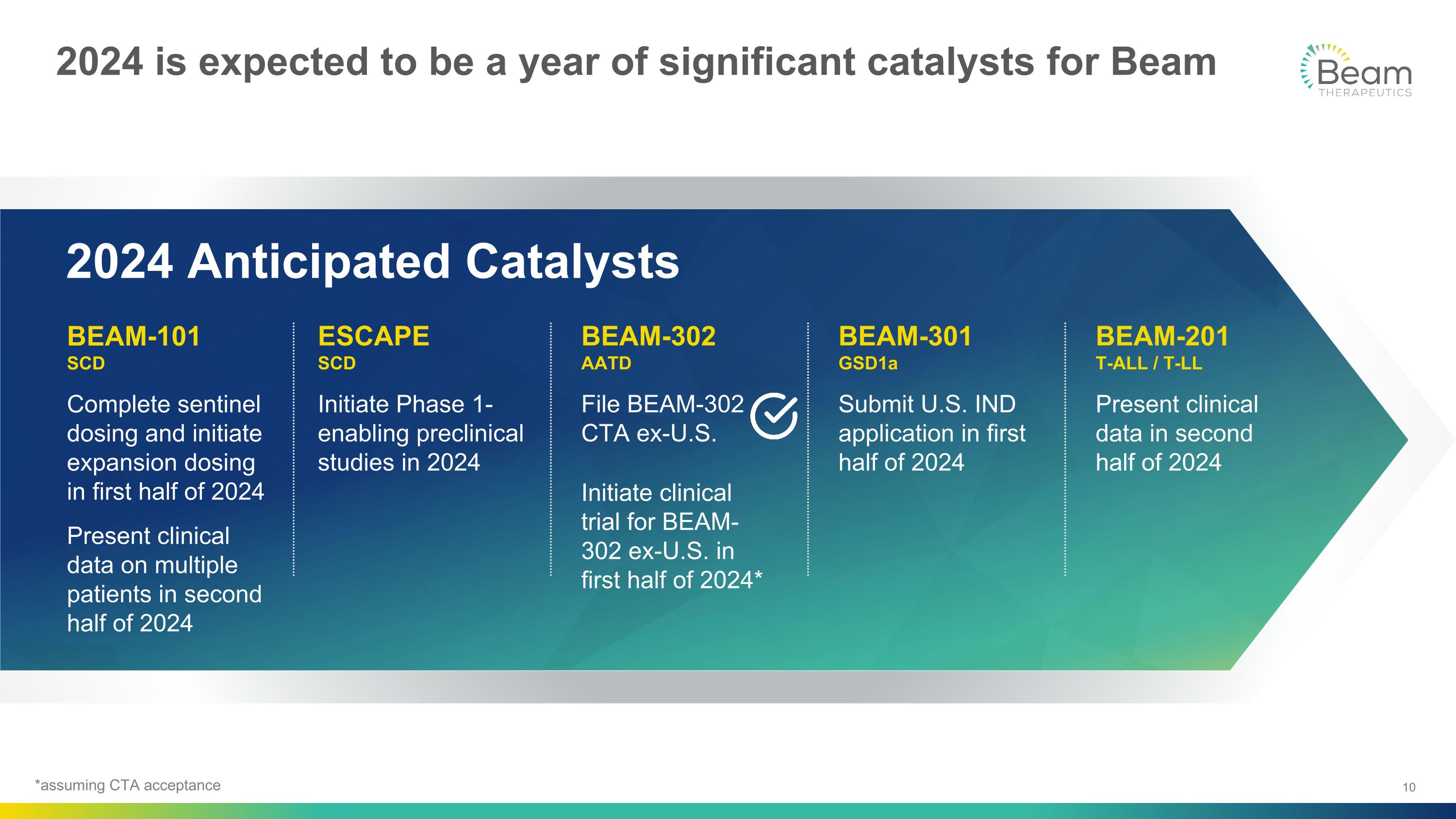
2024 is expected to be a year of significant catalysts for Beam 2024 Anticipated Catalysts BEAM-101 SCD Complete sentinel dosing and initiate expansion dosing in first half of 2024 Present clinical data on multiple patients in second half of 2024 ESCAPE�SCD Initiate Phase 1-enabling preclinical studies in 2024 BEAM-302�AATD File BEAM-302 CTA ex-U.S. Initiate clinical trial for BEAM-302 ex-U.S. in first half of 2024* BEAM-301�GSD1a Submit U.S. IND application in first half of 2024 BEAM-201�T-ALL / T-LL Present clinical data in second half of 2024 *assuming CTA acceptance
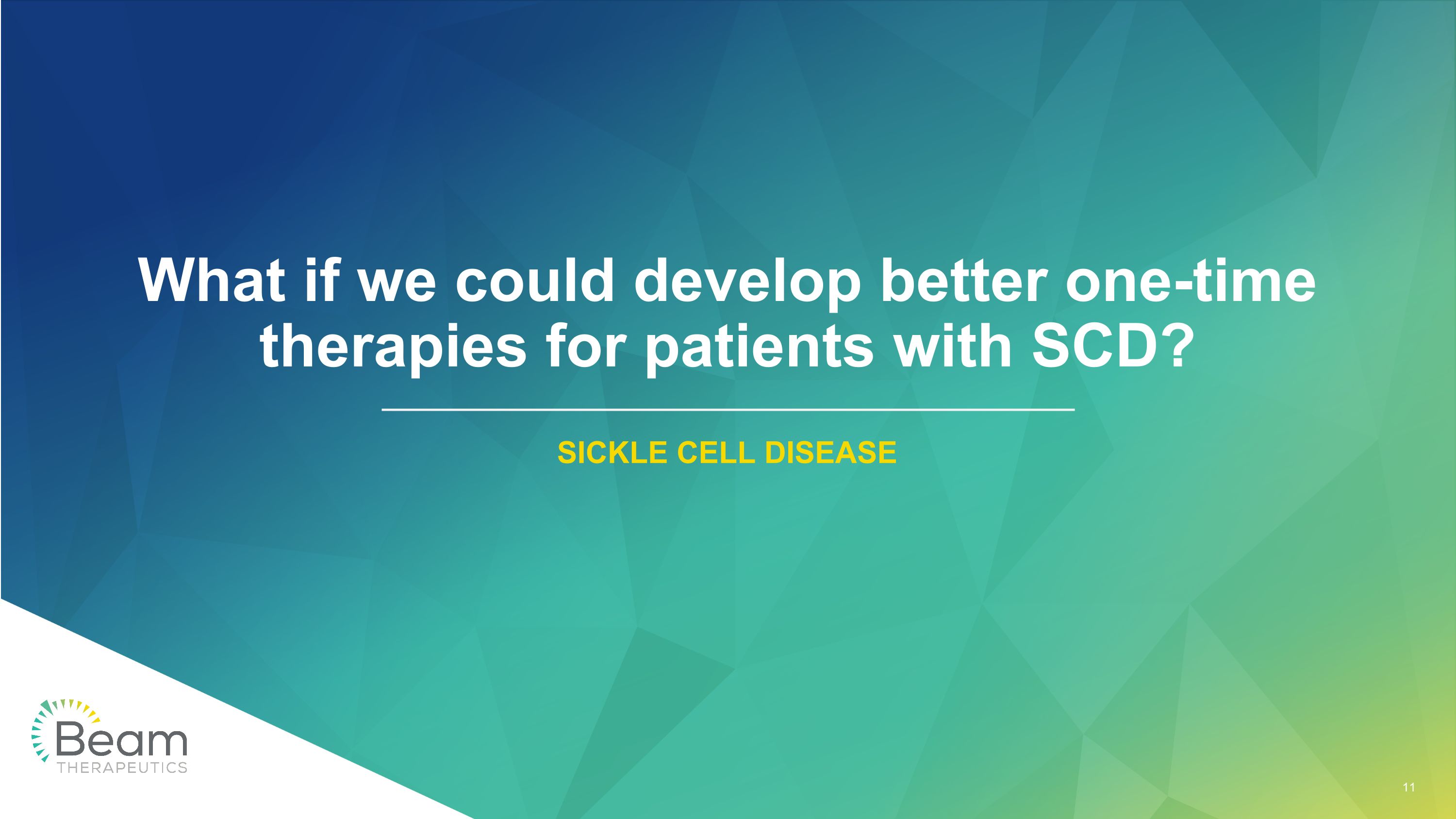
What if we could develop better one-time therapies for patients with SCD? SICKLE CELL DISEASE
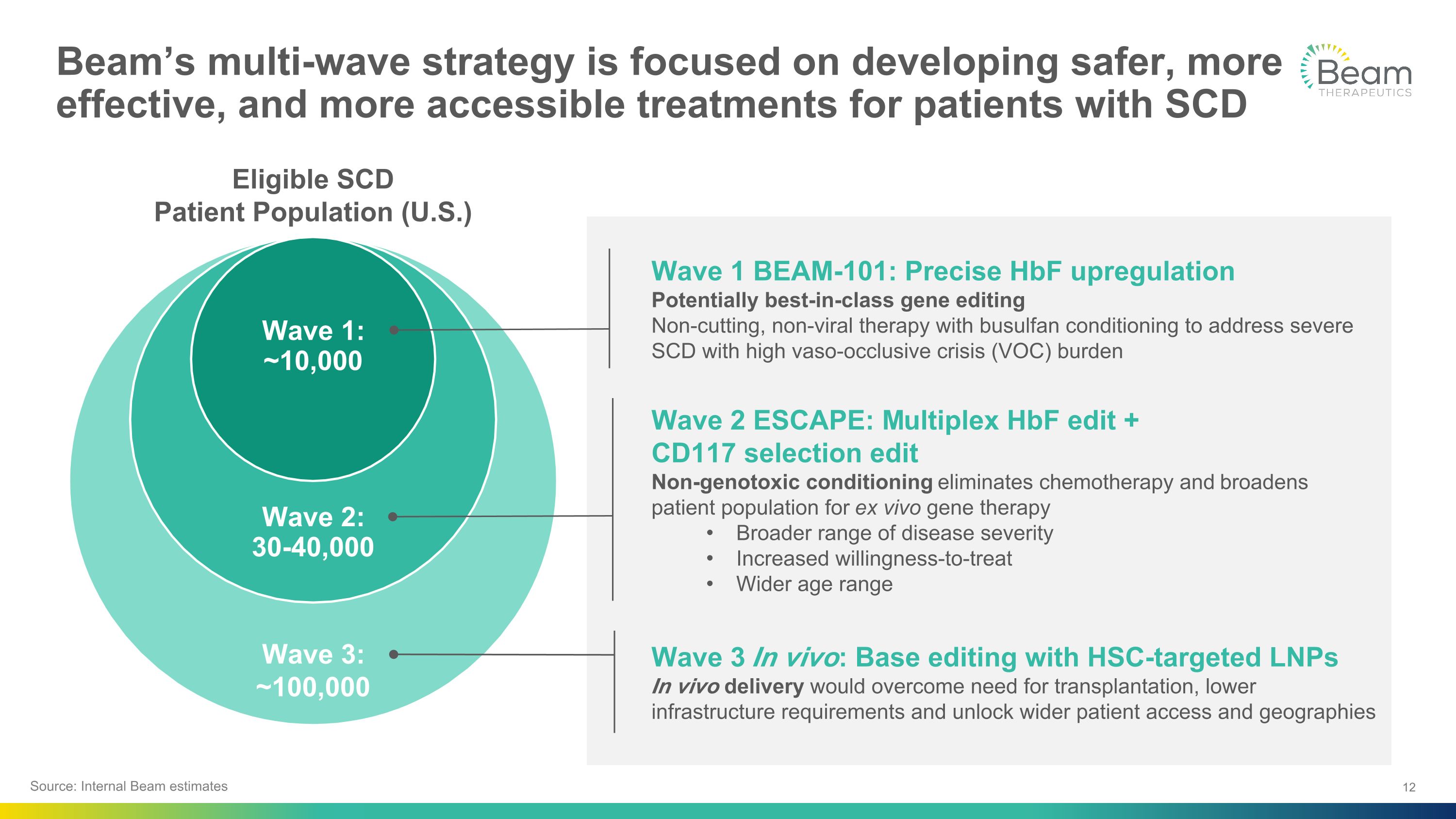
Wave 3: ~100,000 Beam’s multi-wave strategy is focused on developing safer, more effective, and more accessible treatments for patients with SCD Eligible SCD Patient Population (U.S.) Wave 2: 30-40,000 Wave 1: ~10,000 Wave 2 ESCAPE: Multiplex HbF edit + �CD117 selection edit Non-genotoxic conditioning eliminates chemotherapy and broadens patient population for ex vivo gene therapy Broader range of disease severity Increased willingness-to-treat Wider age range Wave 1 BEAM-101: Precise HbF upregulation Potentially best-in-class gene editing �Non-cutting, non-viral therapy with busulfan conditioning to address severe SCD with high vaso-occlusive crisis (VOC) burden Wave 3 In vivo: Base editing with HSC-targeted LNPs In vivo delivery would overcome need for transplantation, lower infrastructure requirements and unlock wider patient access and geographies Source: Internal Beam estimates
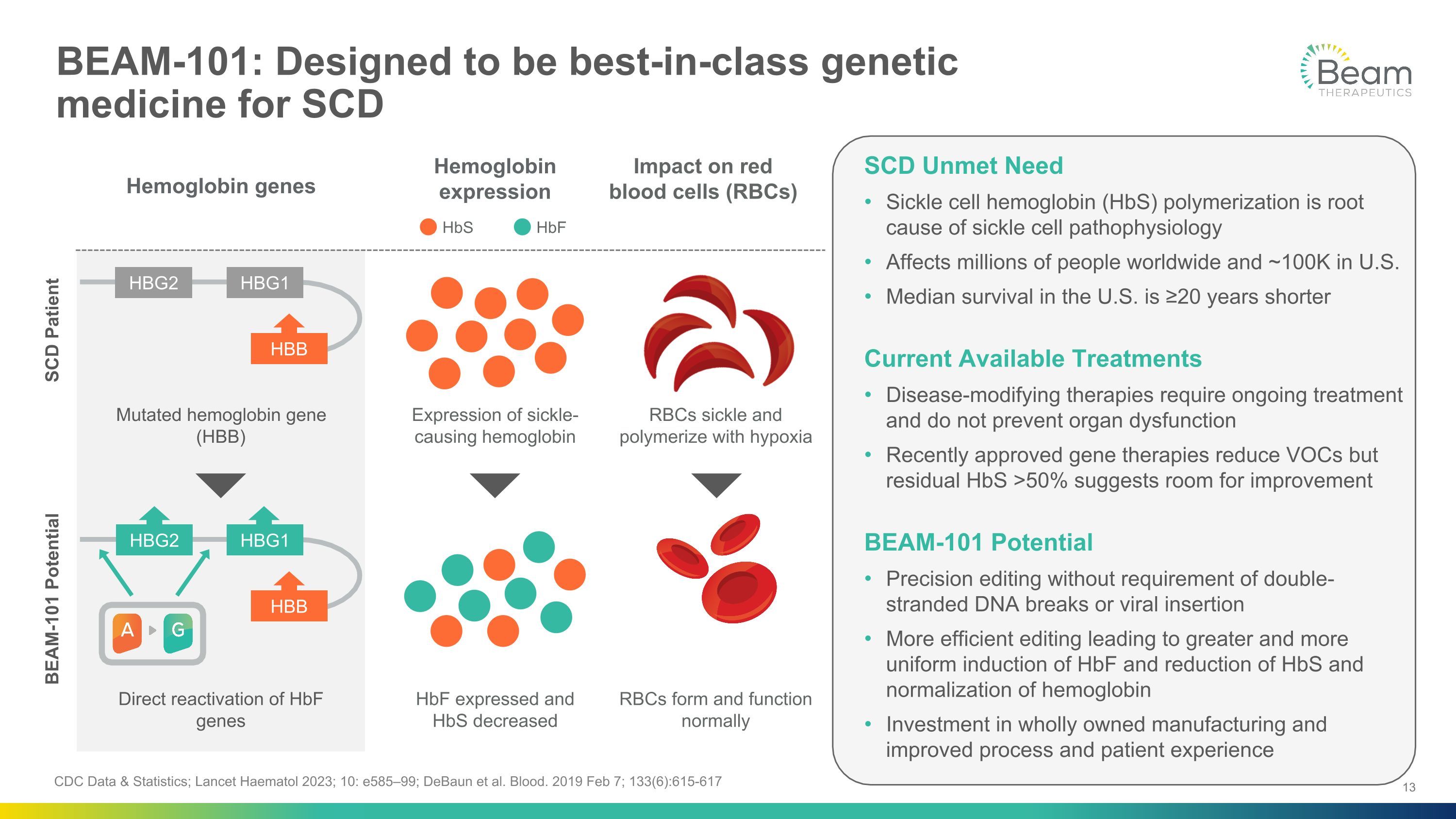
BEAM-101: Designed to be best-in-class genetic �medicine for SCD BEAM-101 Potential SCD Patient HBB HBG1 HBG2 HBB HBG1 HBG2 Mutated hemoglobin gene (HBB) Direct reactivation of HbF genes Hemoglobin genes SCD Unmet Need Sickle cell hemoglobin (HbS) polymerization is root cause of sickle cell pathophysiology Affects millions of people worldwide and ~100K in U.S. Median survival in the U.S. is ≥20 years shorter Current Available Treatments Disease-modifying therapies require ongoing treatment and do not prevent organ dysfunction Recently approved gene therapies reduce VOCs but residual HbS >50% suggests room for improvement BEAM-101 Potential Precision editing without requirement of double-stranded DNA breaks or viral insertion More efficient editing leading to greater and more uniform induction of HbF and reduction of HbS and normalization of hemoglobin Investment in wholly owned manufacturing and improved process and patient experience Hemoglobin expression Expression of sickle-causing hemoglobin HbF expressed and �HbS decreased HbS HbF RBCs form and function normally RBCs sickle and polymerize with hypoxia Impact on red blood cells (RBCs) CDC Data & Statistics; Lancet Haematol 2023; 10: e585–99; DeBaun et al. Blood. 2019 Feb 7; 133(6):615-617
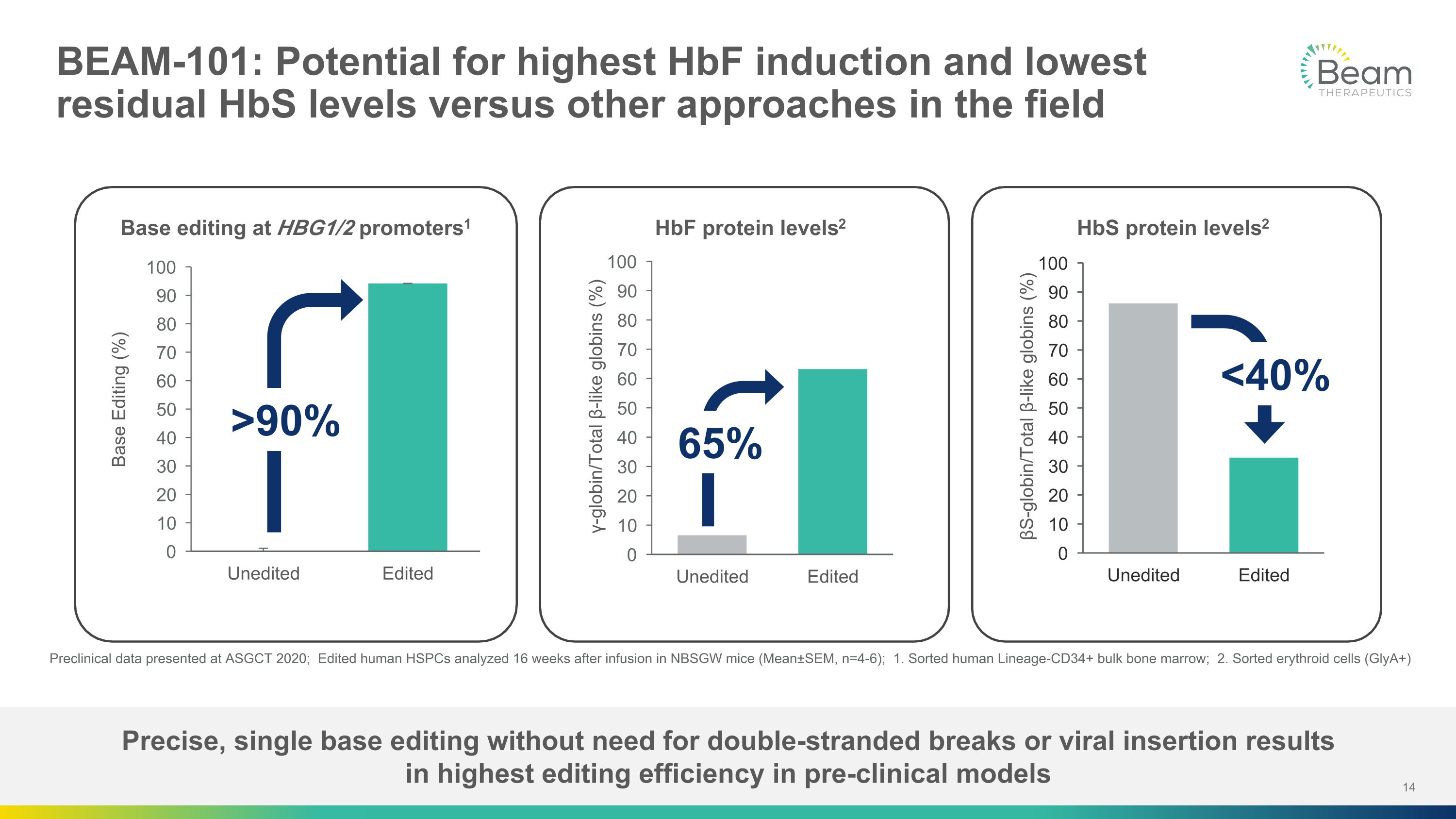
Precise, single base editing without need for double-stranded breaks or viral insertion results in highest editing efficiency in pre-clinical models BEAM-101: Potential for highest HbF induction and lowest residual HbS levels versus other approaches in the field Preclinical data presented at ASGCT 2020; Edited human HSPCs analyzed 16 weeks after infusion in NBSGW mice (Mean±SEM, n=4-6); 1. Sorted human Lineage-CD34+ bulk bone marrow; 2. Sorted erythroid cells (GlyA+) Base editing at HBG1/2 promoters1 HbF protein levels2 HbS protein levels2 >90% 65% <40%
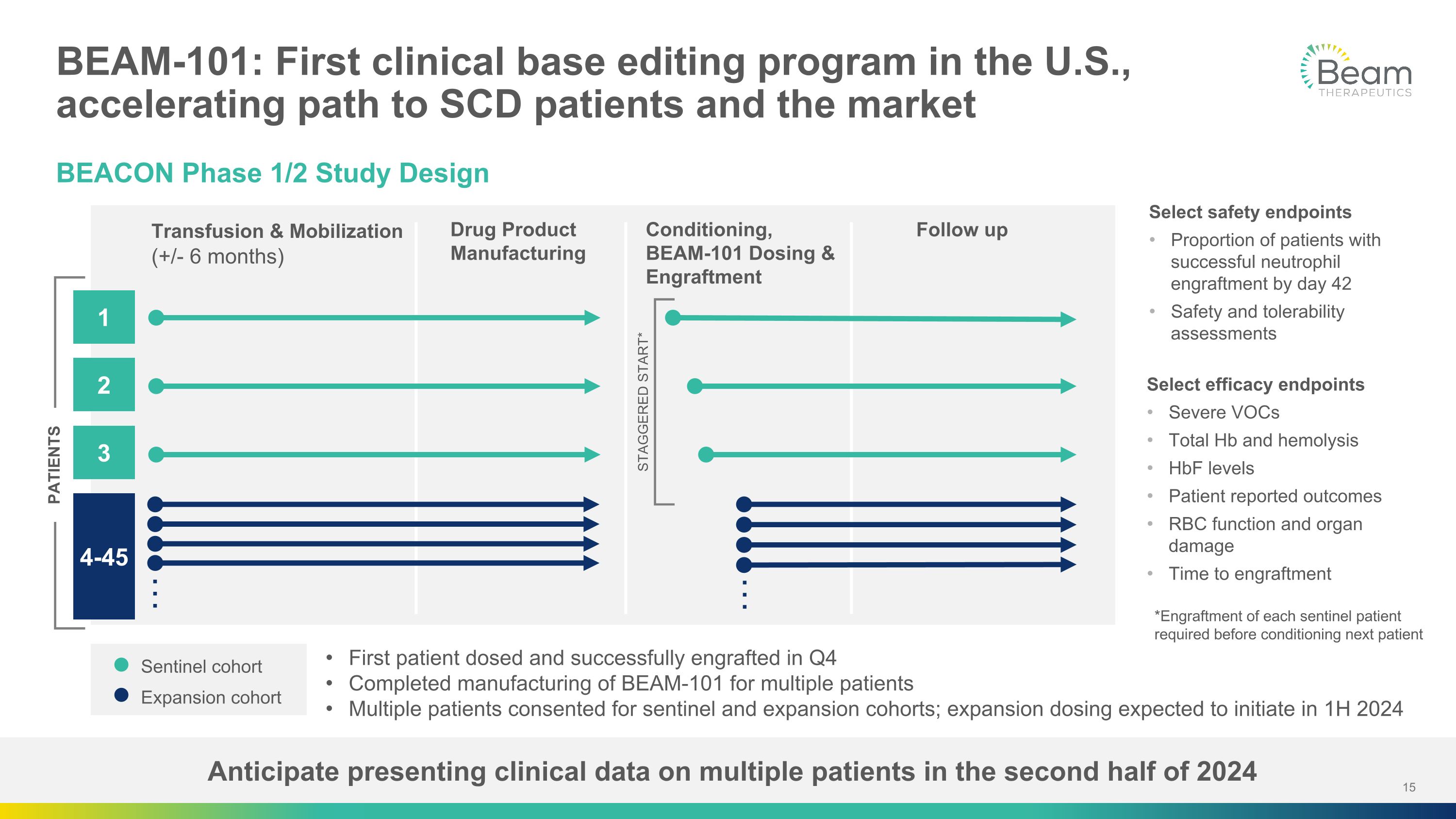
Anticipate presenting clinical data on multiple patients in the second half of 2024 BEAM-101: First clinical base editing program in the U.S., accelerating path to SCD patients and the market BEACON Phase 1/2 Study Design Select safety endpoints Proportion of patients with successful neutrophil engraftment by day 42 Safety and tolerability assessments Select efficacy endpoints Severe VOCs Total Hb and hemolysis HbF levels Patient reported outcomes RBC function and organ damage Time to engraftment Transfusion & Mobilization (+/- 6 months) Drug Product Manufacturing Conditioning, BEAM-101 Dosing & Engraftment Follow up 4-45 1 3 2 STAGGERED START* PATIENTS First patient dosed and successfully engrafted in Q4 Completed manufacturing of BEAM-101 for multiple patients Multiple patients consented for sentinel and expansion cohorts; expansion dosing expected to initiate in 1H 2024 Sentinel cohort Expansion cohort *Engraftment of each sentinel patient required before conditioning next patient … …
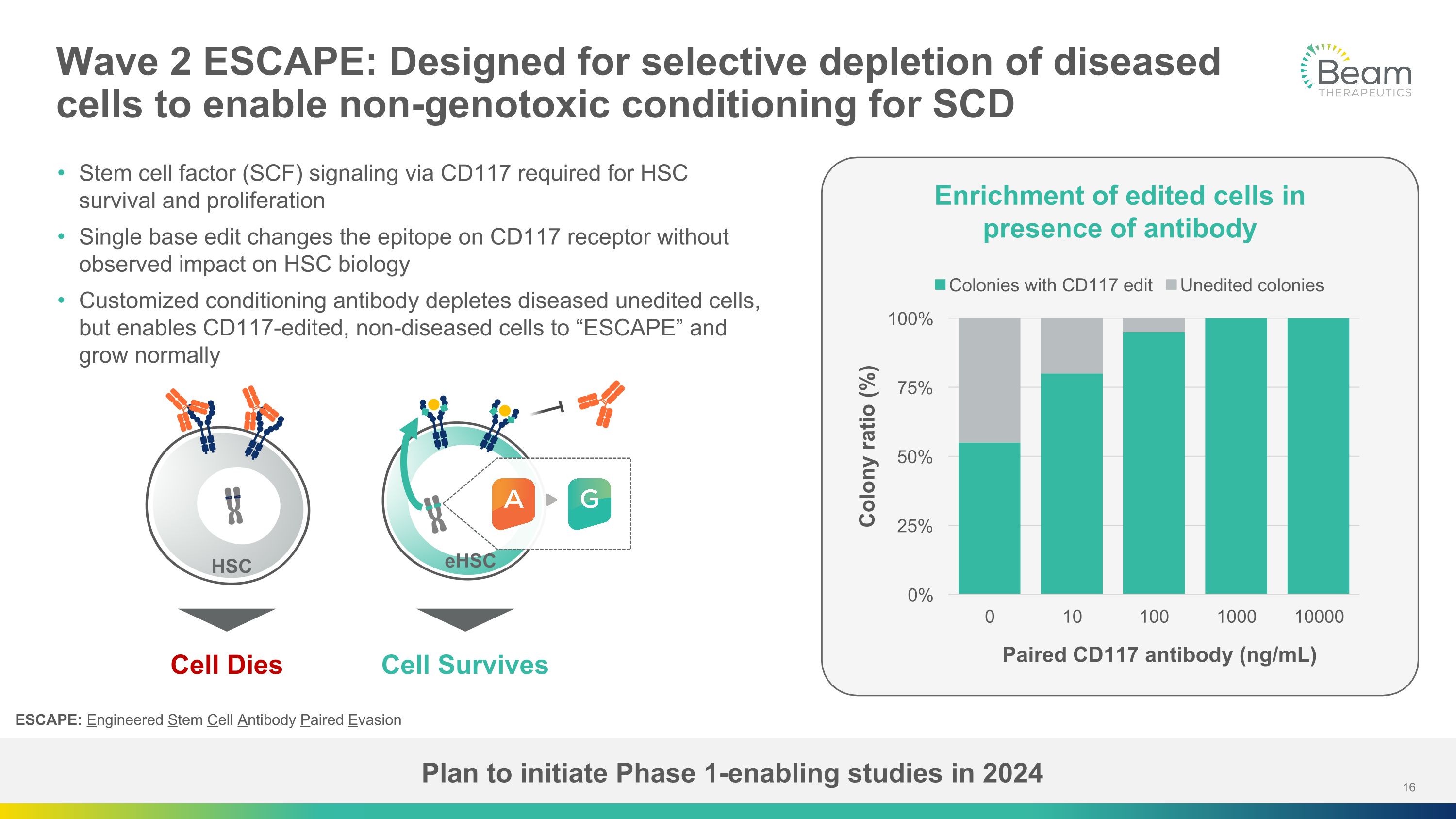
Plan to initiate Phase 1-enabling studies in 2024 Wave 2 ESCAPE: Designed for selective depletion of diseased cells to enable non-genotoxic conditioning for SCD Stem cell factor (SCF) signaling via CD117 required for HSC survival and proliferation Single base edit changes the epitope on CD117 receptor without observed impact on HSC biology Customized conditioning antibody depletes diseased unedited cells, but enables CD117-edited, non-diseased cells to “ESCAPE” and grow normally Enrichment of edited cells in presence of antibody Paired CD117 antibody (ng/mL) HSC eHSC Cell Dies Cell Survives ESCAPE: Engineered Stem Cell Antibody Paired Evasion Colony ratio (%)
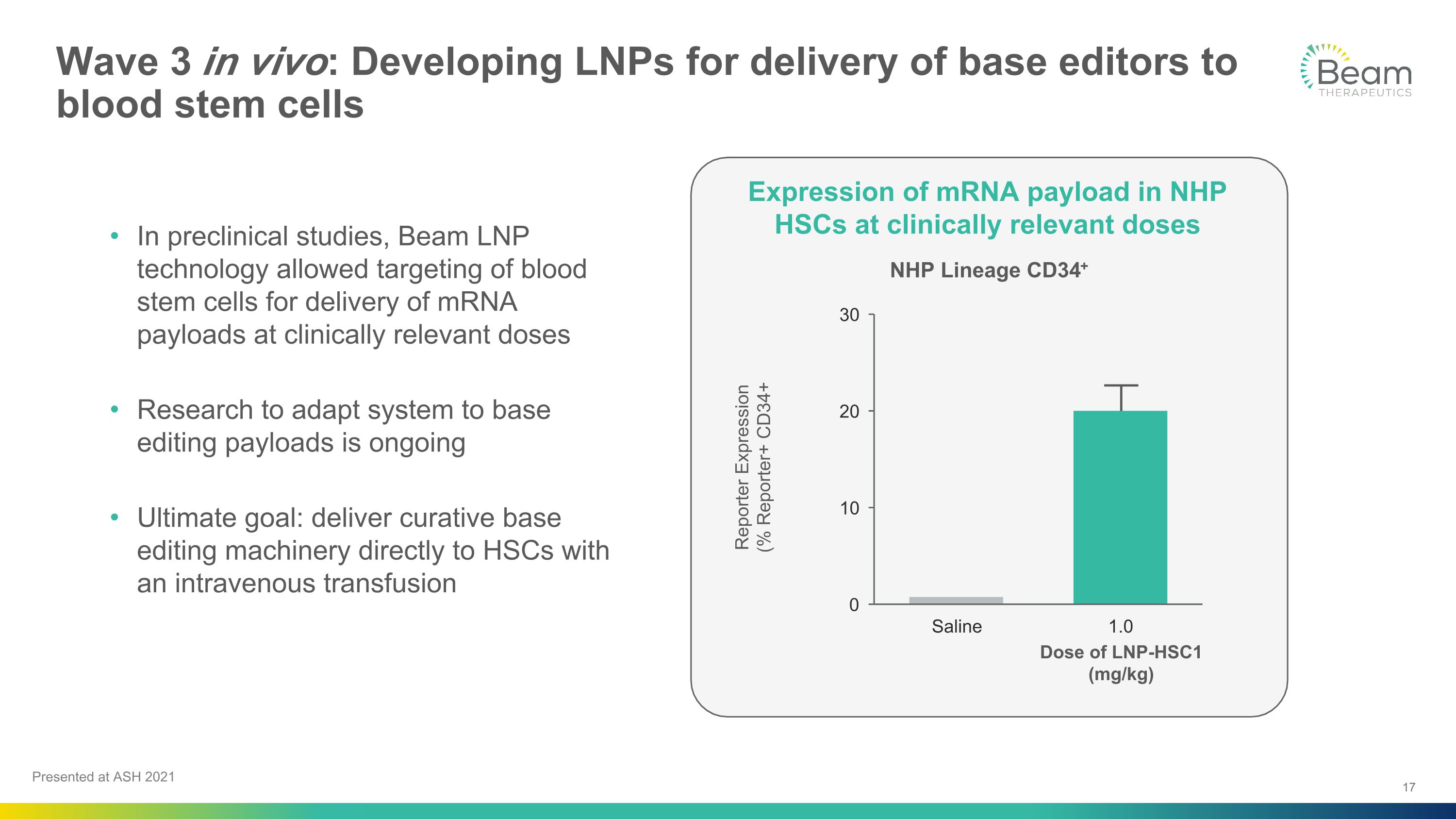
Wave 3 in vivo: Developing LNPs for delivery of base editors to blood stem cells Presented at ASH 2021 Expression of mRNA payload in NHP HSCs at clinically relevant doses In preclinical studies, Beam LNP technology allowed targeting of blood stem cells for delivery of mRNA payloads at clinically relevant doses Research to adapt system to base editing payloads is ongoing Ultimate goal: deliver curative base editing machinery directly to HSCs with an intravenous transfusion NHP Lineage CD34+ Dose of LNP-HSC1�(mg/kg)
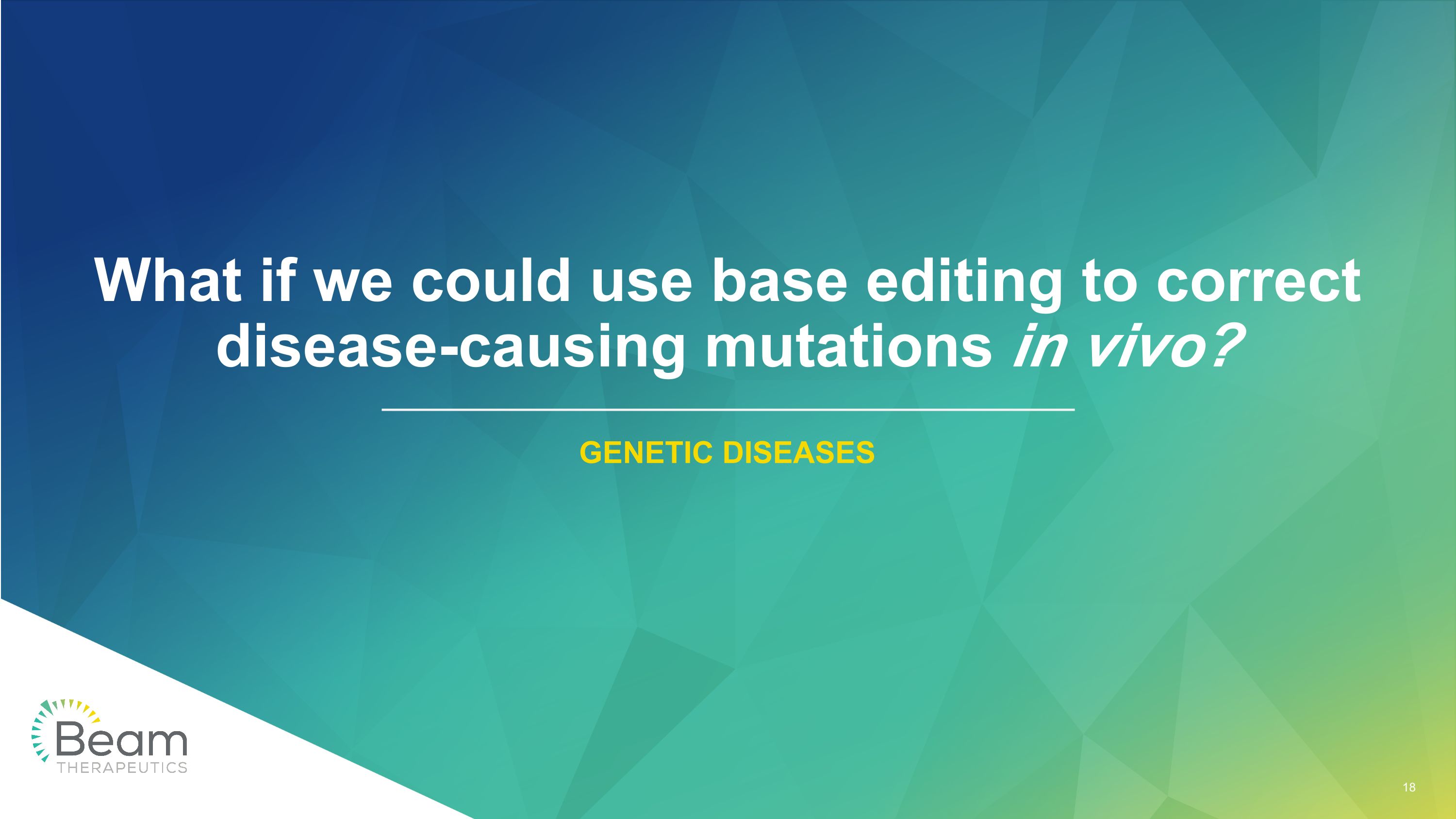
What if we could use base editing to correct disease-causing mutations in vivo? GENETIC DISEASES
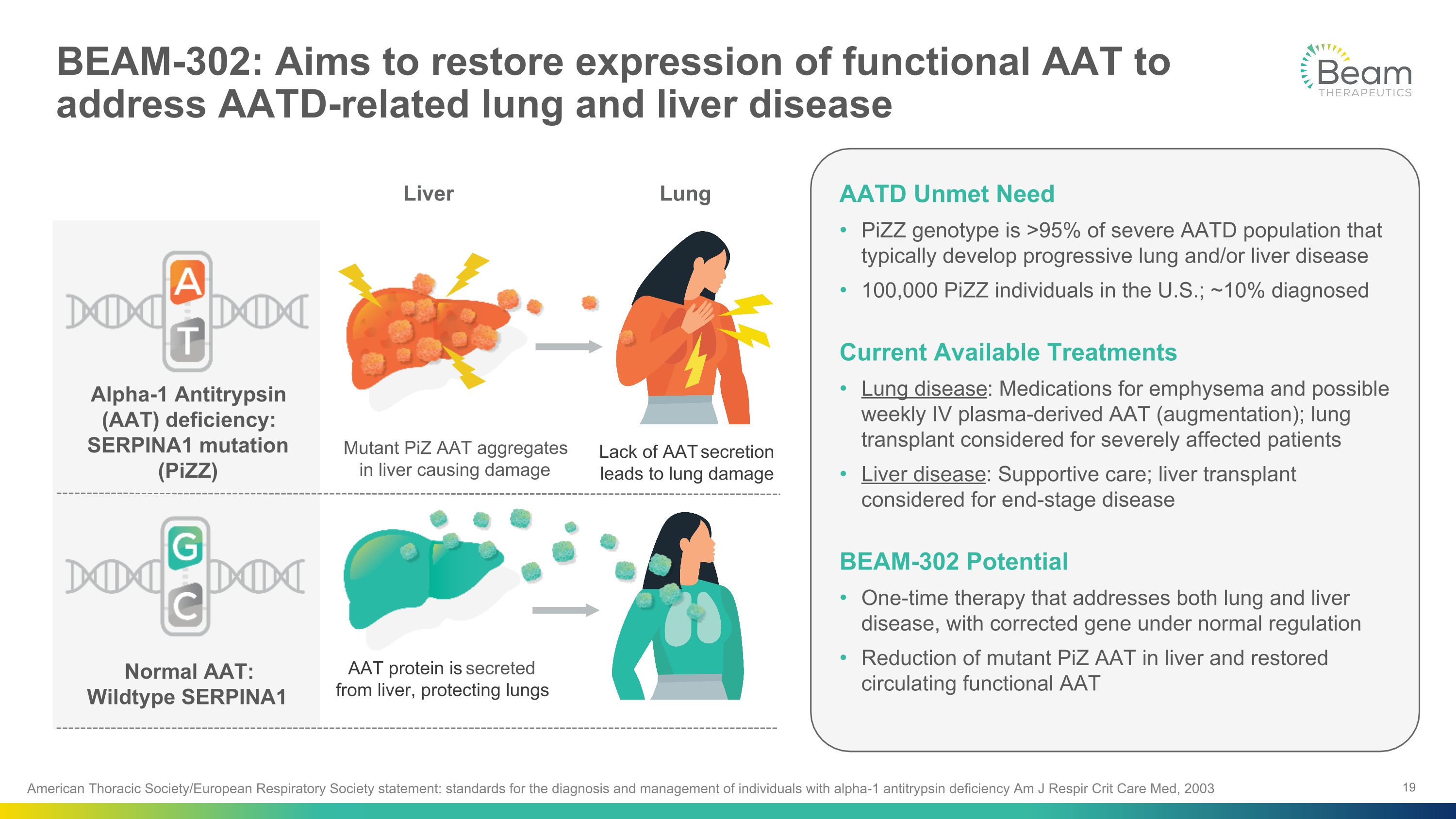
BEAM-302: Aims to restore expression of functional AAT to address AATD-related lung and liver disease AATD Unmet Need PiZZ genotype is >95% of severe AATD population that typically develop progressive lung and/or liver disease 100,000 PiZZ individuals in the U.S.; ~10% diagnosed Current Available Treatments Lung disease: Medications for emphysema and possible weekly IV plasma-derived AAT (augmentation); lung transplant considered for severely affected patients Liver disease: Supportive care; liver transplant considered for end-stage disease BEAM-302 Potential One-time therapy that addresses both lung and liver disease, with corrected gene under normal regulation Reduction of mutant PiZ AAT in liver and restored circulating functional AAT Liver Lung Alpha-1 Antitrypsin (AAT) deficiency: SERPINA1 mutation (PiZZ) Mutant PiZ AAT aggregates in liver causing damage Lack of AAT secretion�leads to lung damage American Thoracic Society/European Respiratory Society statement: standards for the diagnosis and management of individuals with alpha-1 antitrypsin deficiency Am J Respir Crit Care Med, 2003 Normal AAT: Wildtype SERPINA1 AAT protein is secreted from liver, protecting lungs
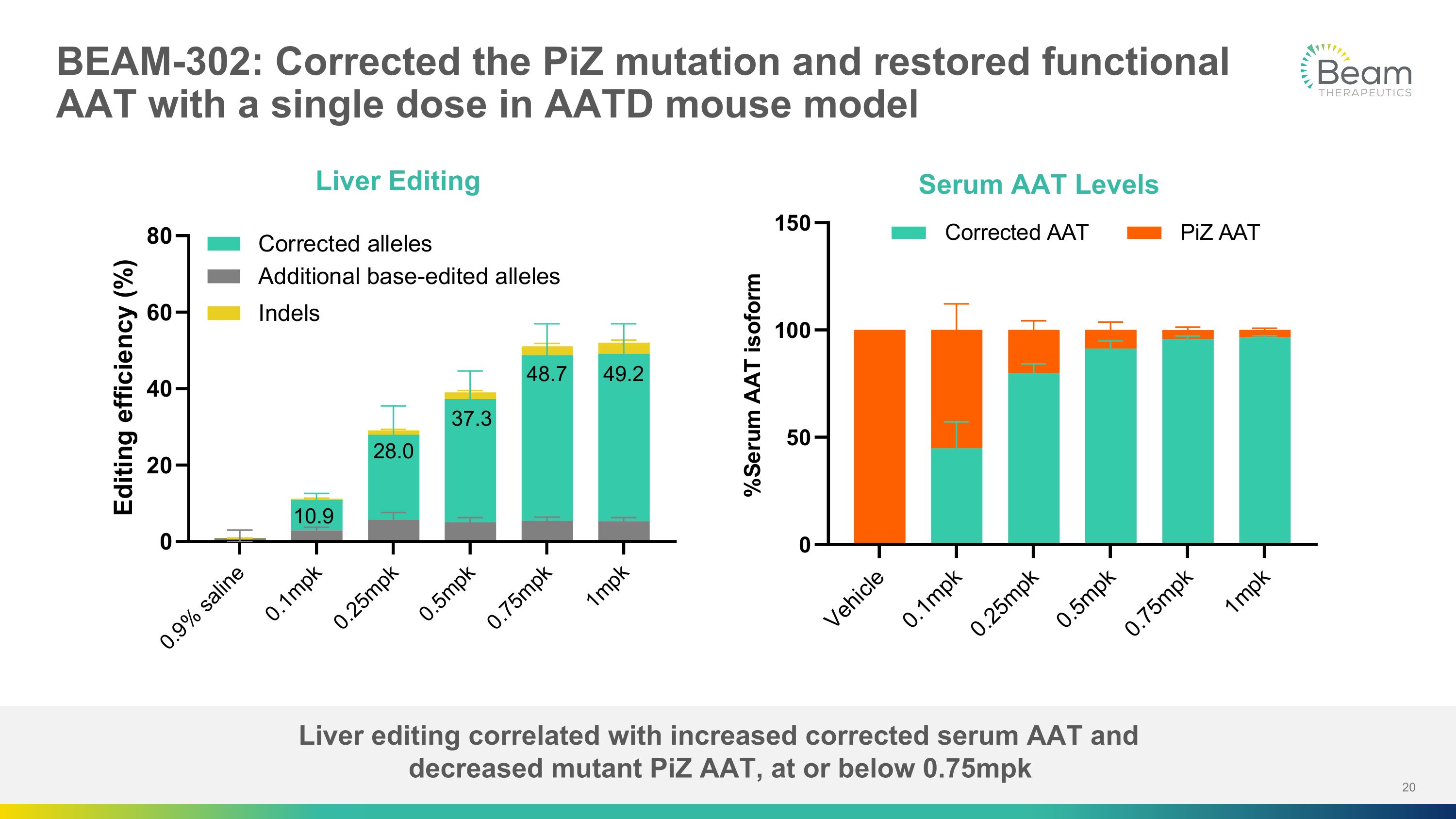
BEAM-302: Corrected the PiZ mutation and restored functional AAT with a single dose in AATD mouse model Liver editing correlated with increased corrected serum AAT and decreased mutant PiZ AAT, at or below 0.75mpk Liver Editing Serum AAT Levels
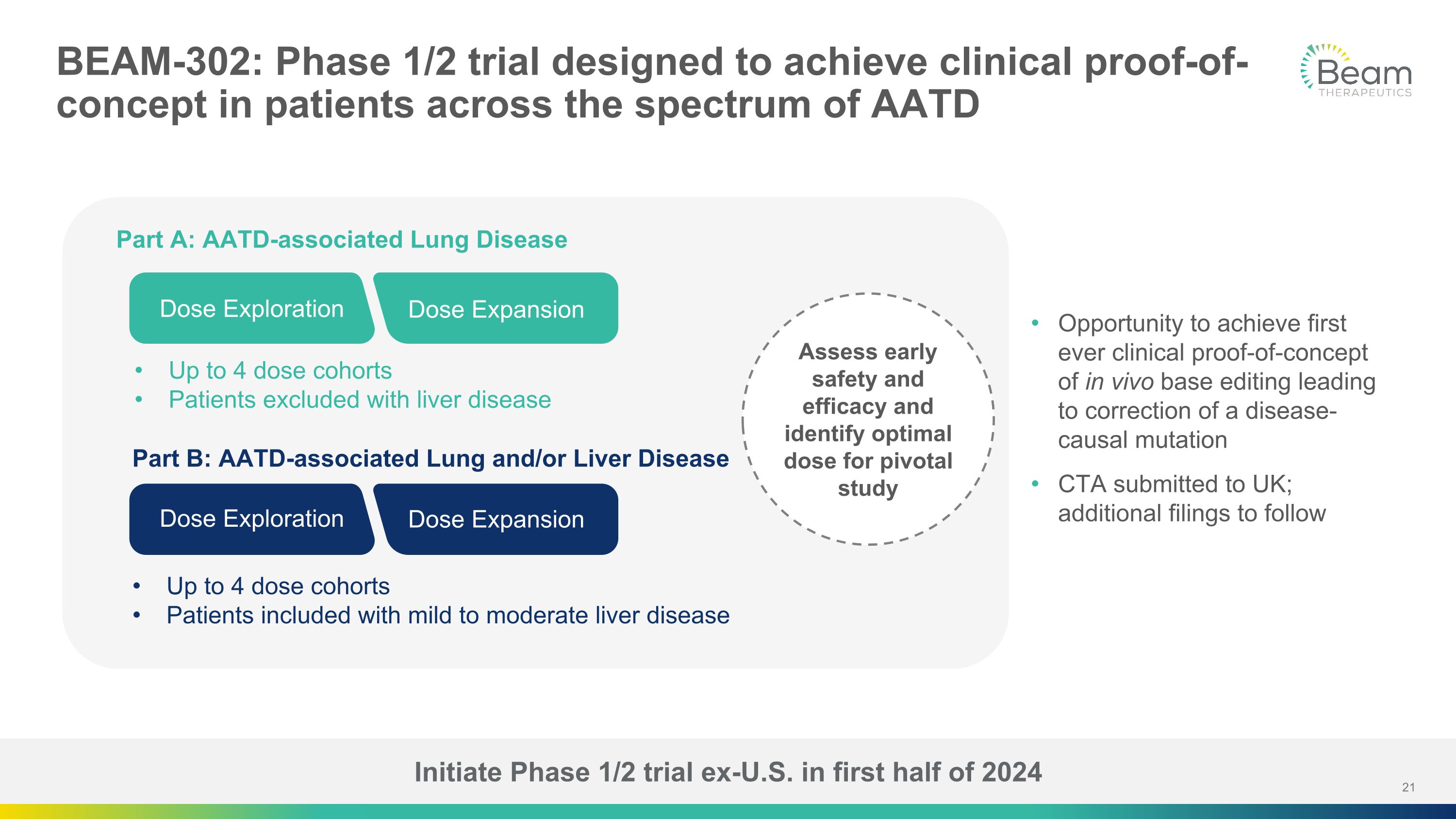
BEAM-302: Phase 1/2 trial designed to achieve clinical proof-of-concept in patients across the spectrum of AATD Opportunity to achieve first ever clinical proof-of-concept of in vivo base editing leading to correction of a disease-causal mutation CTA submitted to UK; additional filings to follow Part A: AATD-associated Lung Disease Part B: AATD-associated Lung and/or Liver Disease Assess early safety and efficacy and identify optimal dose for pivotal study Up to 4 dose cohorts Patients included with mild to moderate liver disease Up to 4 dose cohorts Patients excluded with liver disease Initiate Phase 1/2 trial ex-U.S. in first half of 2024 Dose Exploration Dose Expansion Dose Exploration Dose Expansion
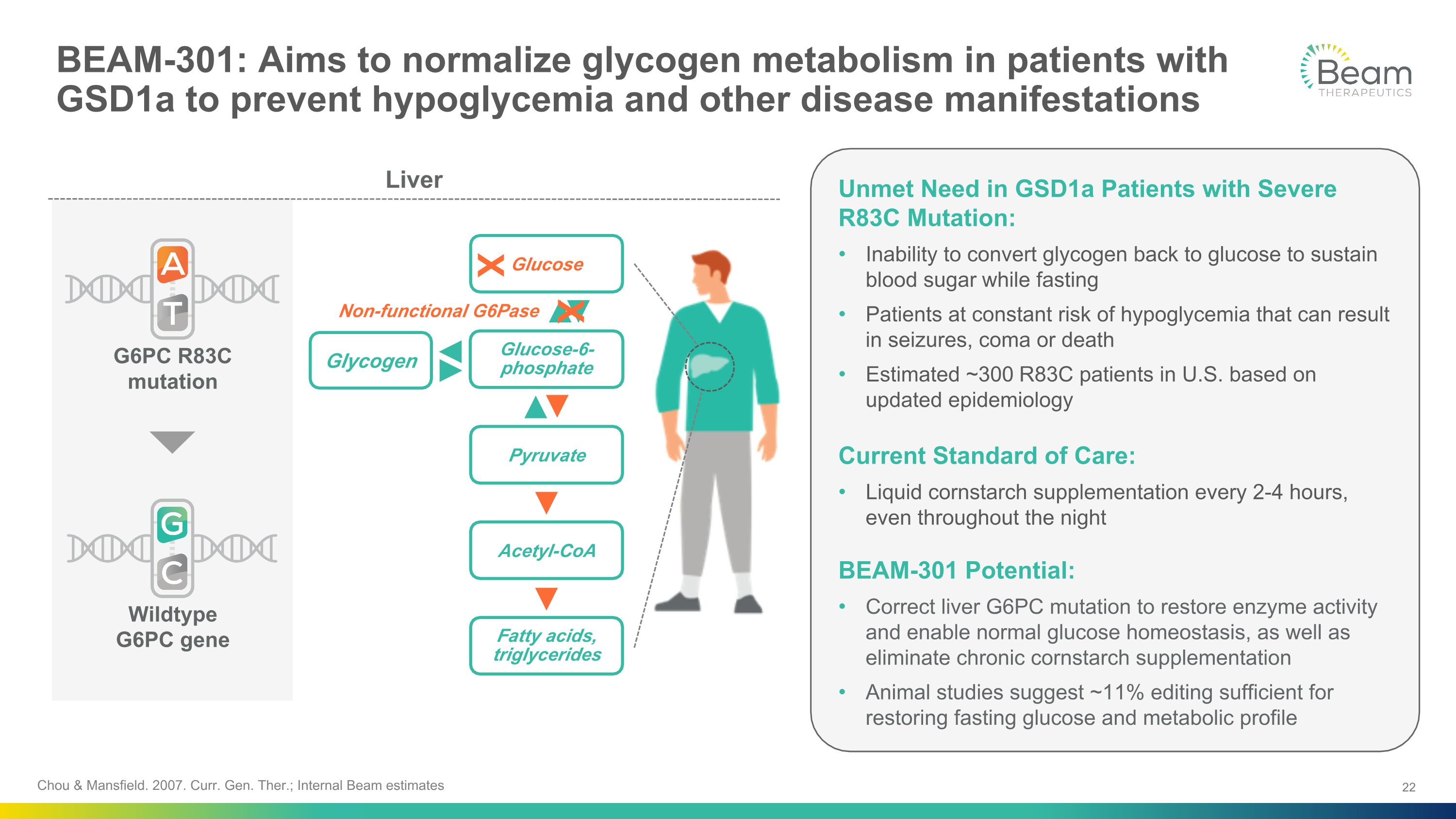
Chou & Mansfield. 2007. Curr. Gen. Ther.; Internal Beam estimates Wildtype �G6PC gene G6PC R83C mutation BEAM-301: Aims to normalize glycogen metabolism in patients with GSD1a to prevent hypoglycemia and other disease manifestations Liver Unmet Need in GSD1a Patients with Severe R83C Mutation: Inability to convert glycogen back to glucose to sustain blood sugar while fasting Patients at constant risk of hypoglycemia that can result in seizures, coma or death Estimated ~300 R83C patients in U.S. based on updated epidemiology Current Standard of Care: Liquid cornstarch supplementation every 2-4 hours, even throughout the night BEAM-301 Potential: Correct liver G6PC mutation to restore enzyme activity and enable normal glucose homeostasis, as well as eliminate chronic cornstarch supplementation Animal studies suggest ~11% editing sufficient for restoring fasting glucose and metabolic profile Non-functional G6Pase Glycogen Glucose Glucose-6- phosphate Pyruvate Acetyl-CoA Fatty acids, triglycerides X X
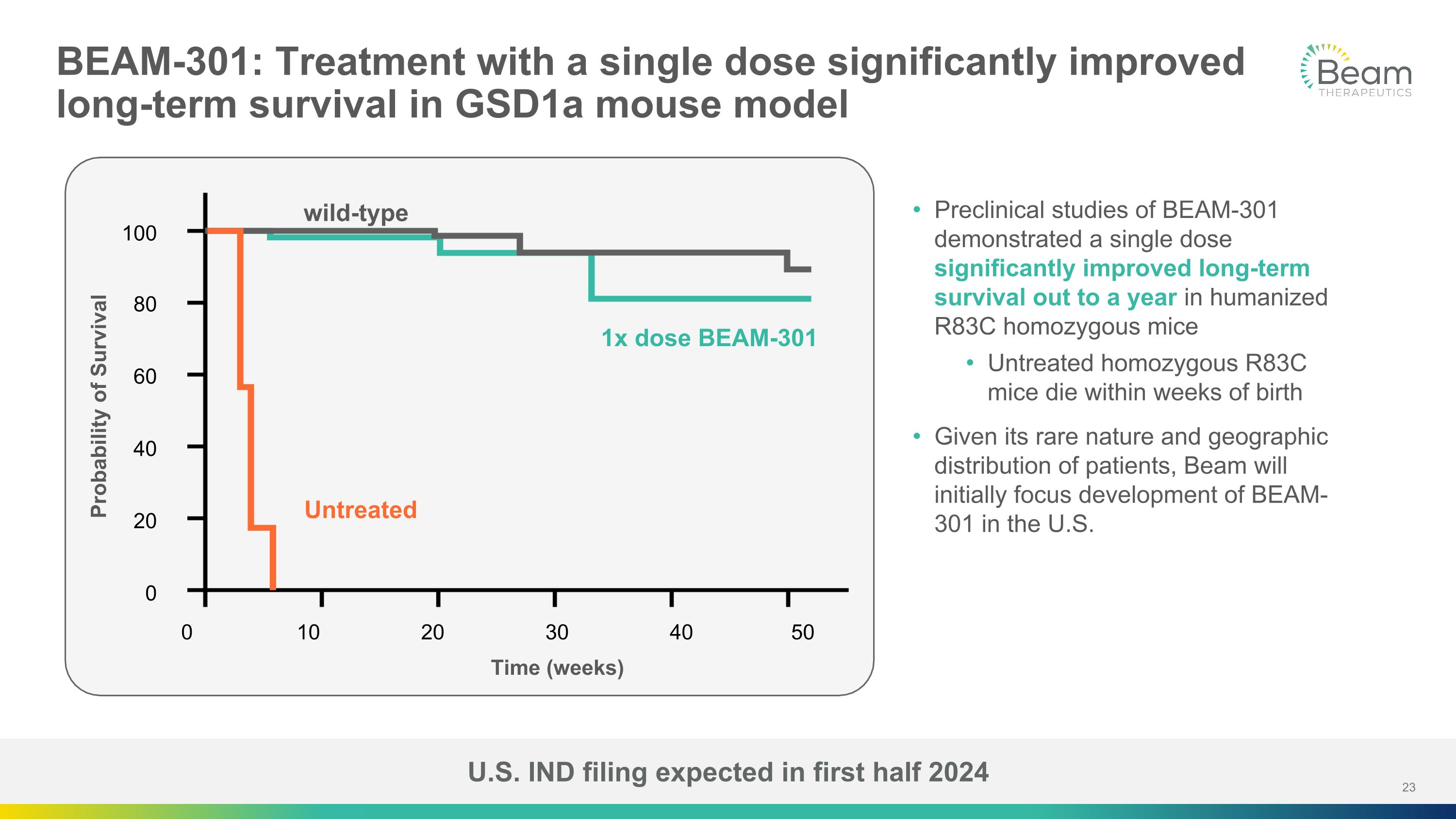
U.S. IND filing expected in first half 2024 BEAM-301: Treatment with a single dose significantly improved long-term survival in GSD1a mouse model Preclinical studies of BEAM-301 demonstrated a single dose significantly improved long-term survival out to a year in humanized R83C homozygous mice Untreated homozygous R83C mice die within weeks of birth Given its rare nature and geographic distribution of patients, Beam will initially focus development of BEAM-301 in the U.S. 0 Probability of Survival 20 40 60 80 100 10 20 30 40 50 1x dose BEAM-301 wild-type Untreated Time (weeks) 0
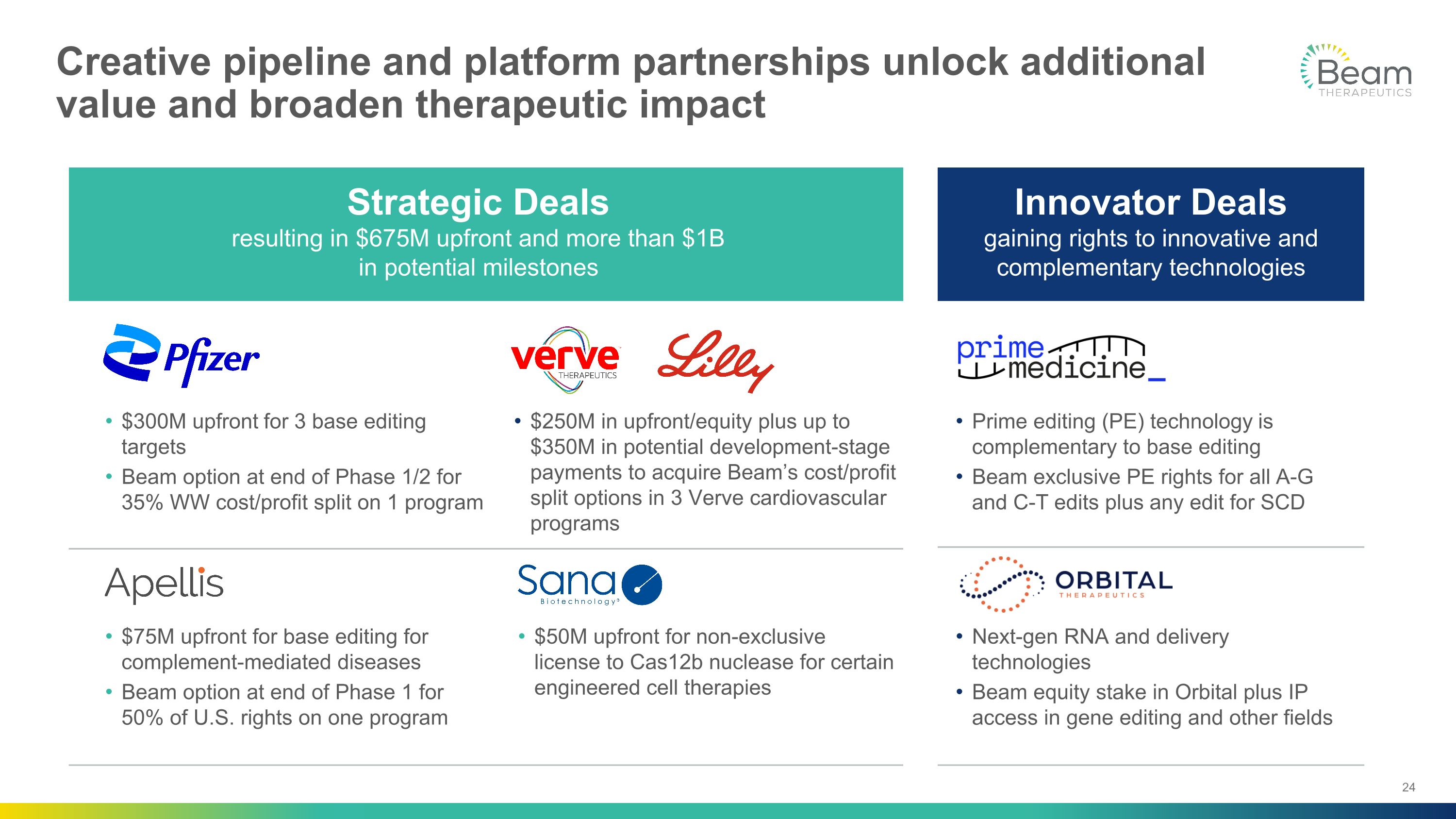
Creative pipeline and platform partnerships unlock additional value and broaden therapeutic impact Strategic Deals resulting in $675M upfront and more than $1B in potential milestones Innovator Deals gaining rights to innovative and complementary technologies $300M upfront for 3 base editing targets Beam option at end of Phase 1/2 for 35% WW cost/profit split on 1 program $75M upfront for base editing for complement-mediated diseases Beam option at end of Phase 1 for 50% of U.S. rights on one program $50M upfront for non-exclusive license to Cas12b nuclease for certain engineered cell therapies $250M in upfront/equity plus up to $350M in potential development-stage payments to acquire Beam’s cost/profit split options in 3 Verve cardiovascular programs Prime editing (PE) technology is complementary to base editing Beam exclusive PE rights for all A-G and C-T edits plus any edit for SCD Next-gen RNA and delivery technologies Beam equity stake in Orbital plus IP access in gene editing and other fields
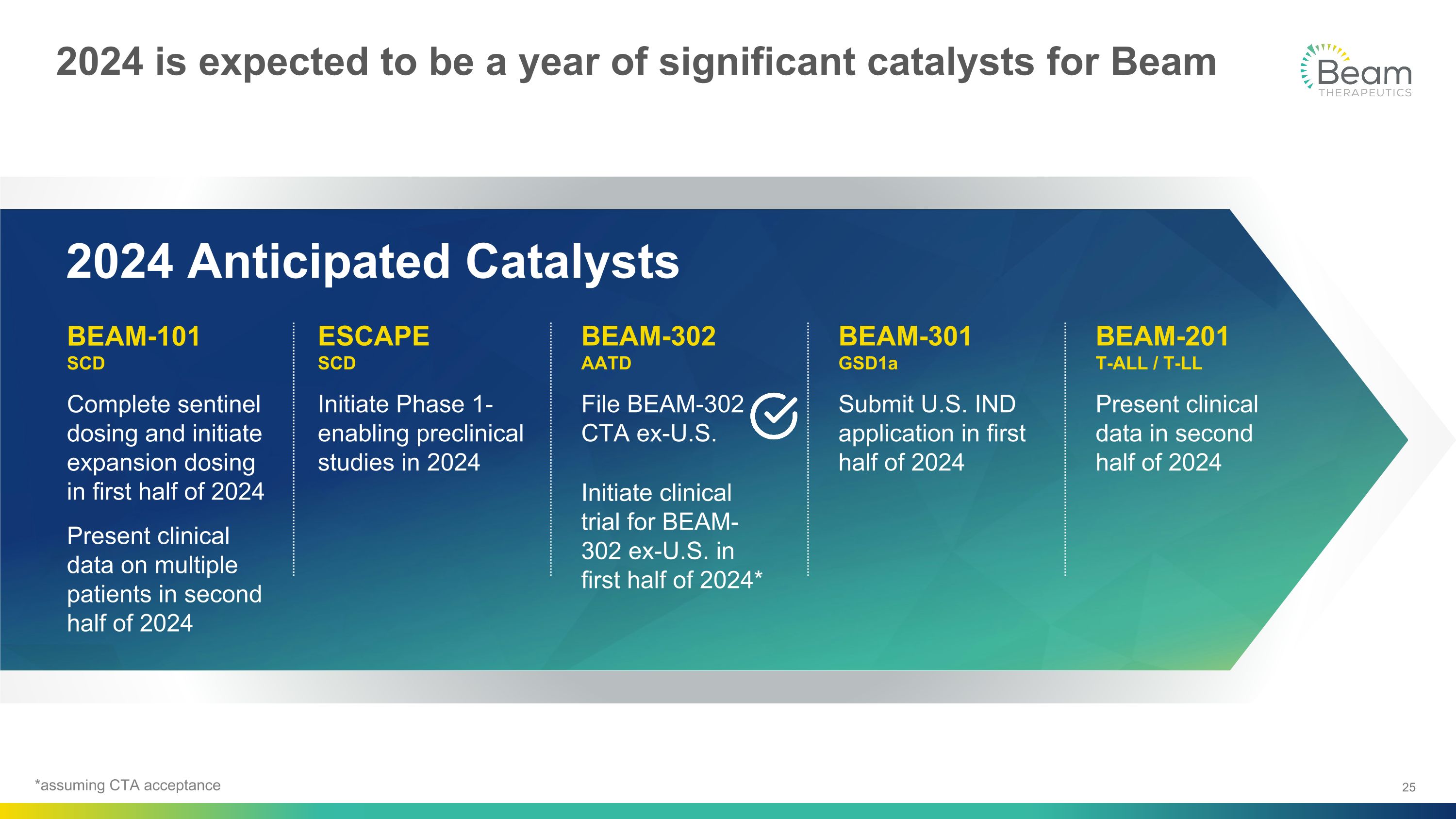
2024 is expected to be a year of significant catalysts for Beam 2024 Anticipated Catalysts BEAM-101 SCD Complete sentinel dosing and initiate expansion dosing in first half of 2024 Present clinical data on multiple patients in second half of 2024 ESCAPE�SCD Initiate Phase 1-enabling preclinical studies in 2024 BEAM-302�AATD File BEAM-302 CTA ex-U.S. Initiate clinical trial for BEAM-302 ex-U.S. in first half of 2024* BEAM-301�GSD1a Submit U.S. IND application in first half of 2024 BEAM-201�T-ALL / T-LL Present clinical data in second half of 2024 *assuming CTA acceptance
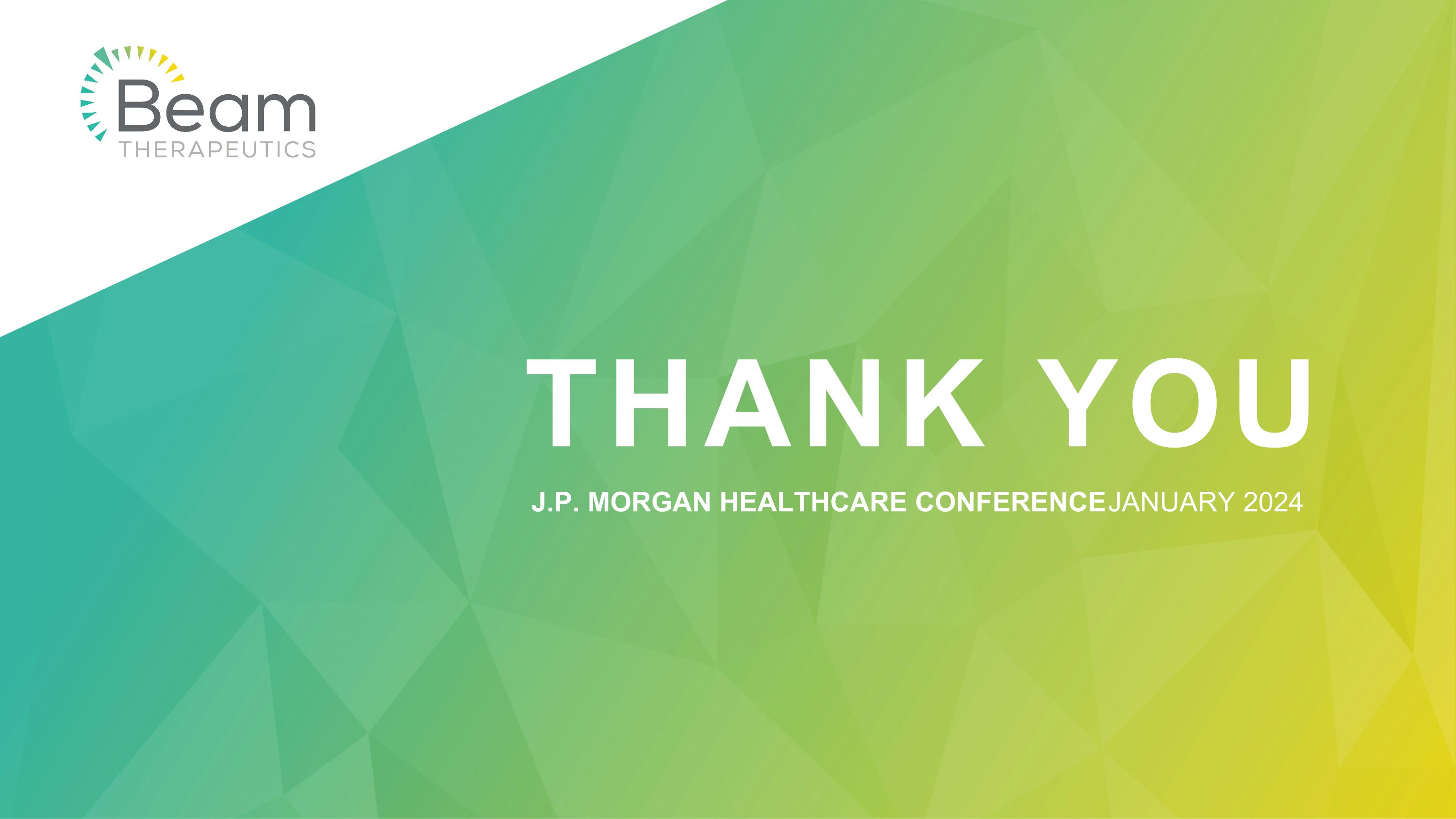
THANK YOU J.P. MORGAN HEALTHCARE CONFERENCE JANUARY 2024

Beam Therapeutics Highlights Progress Across Base Editing Portfolio and Outlines 2024 Anticipated Milestones
First Patient Dosed and Successfully Engrafted in BEACON Phase 1/2 Trial of BEAM-101 in Patients with Severe Sickle Cell Disease; Significant Enrollment Progress Supports First Expected Clinical Data Readout in Second Half of 2024
European Clinical Trial Application (CTA) Submitted for BEAM-302; Trial Initiation in Alpha-1 Antitrypsin Deficiency Planned for First Half of 2024
Investigational New Drug (IND) Application for BEAM-301 On-track for First Half of 2024
Cash Runway Expected to Support Operating Plans into 2027
CAMBRIDGE, Mass., Jan. 8, 2024 - Beam Therapeutics Inc. (Nasdaq: BEAM), a biotechnology company developing precision genetic medicines through base editing, today reported progress across the company’s hematology and genetic disease portfolios and provided updates on anticipated upcoming milestones.
“Our vision is to establish Beam as a sustainable, fully integrated company pioneering a new class of genetic medicines with base editing. We made tremendous progress toward this goal in 2023, including opening our own GMP manufacturing facility, dosing the first patients in multiple ex vivo clinical programs, including BEAM-101 for sickle cell disease (SCD), and accelerating our in vivo program for alpha-1 antitrypsin deficiency (AATD), as exemplified by the filing of our CTA for BEAM-302,” said John Evans, chief executive officer of Beam Therapeutics. “Building on this momentum and benefiting from the significant clinical validation, regulatory clarity, and scientific breakthroughs occurring in the broader gene editing field, we expect 2024 to be a year of significant catalysts for Beam. Our highly differentiated SCD and AATD programs have the potential to provide best-in-class therapies for significant patient populations with high unmet need, while also establishing a platform for sustainable long-term growth across multiple therapeutic areas.”
Pipeline Updates and 2024 Anticipated Milestones
Sickle Cell Disease (SCD) Franchise
Beam is pursuing a long-term, staged development strategy for SCD that has three Waves of innovation intended to progressively expand the reach of our base editing approach to broader subsets of patients.
•Wave 1: BEAM-101 is an autologous investigational cell therapy designed to efficiently and uniformly increase fetal hemoglobin (HbF) in red blood cells without relying on double stranded breaks, offering a potentially best-in-class profile. Preclinical models

suggest base editing could lead to improved HbF induction and lower residual disease-causing hemoglobin S compared to existing gene therapy options.
oThe first patient was dosed in the fourth quarter of 2023 and successfully achieved engraftment in the BEACON Phase 1/2 clinical trial, an open-label, single-arm, multicenter study evaluating the safety and efficacy of BEAM-101 in adult patients with severe SCD. Treatment with BEAM-101, in which the edited cell product is delivered in an autologous bone marrow transplant, will occur on a sequential basis for the first three patients treated in the trial, and then will be given in parallel for all subsequent patients.
oPatients have continued to be consented in the BEACON trial, and Beam anticipates dosing the remaining two patients in the sentinel cohort and initiating dosing in patients in the expansion cohort in the first half of 2024.
oThe company is on-track to report initial data on multiple patients from the BEACON trial in the second half of 2024.
•Wave 2: Beam continues to advance and invest in its Engineered Stem Cell Antibody Paired Evasion (ESCAPE) conditioning platform and anticipates initiating Phase 1-enabling preclinical studies for the program in 2024. ESCAPE aims to avoid the toxicities associated with currently available conditioning regimens for patients with SCD required prior to autologous transplant.
•Wave 3: The company is also exploring the potential for in vivo base editing programs for SCD, in which base editors would be delivered to the patient through intravenous infusion of lipid nanoparticles (LNPs) targeted to hematopoietic stem cells, eliminating the need for transplantation altogether.
Genetic Disease Franchise
Beam seeks to treat genetic diseases using single course gene editing therapies delivered through intravenous infusion of LNPs, which are a clinically validated technology for delivery of nucleic acid payloads to the liver.
•BEAM-302, the company’s priority genetic disease program, is a potential treatment for AATD, which is characterized by early onset emphysema, liver disease, and increased all-cause mortality compared to the general population. There is a large unmet need for novel therapies that can treat patients with AATD-associated lung and liver disease.
oBEAM-302 is a potentially best-in-class liver-targeting LNP formulation of base editing reagents designed to correct the PiZ allele, the most common gene variant associated with severe AATD. Approximately 100,000 patients in the U.S. are estimated to carry the PiZZ genotype.
oPreclinical data to date demonstrated that treatment with BEAM-302 led to significantly increased levels of corrected and functional alpha-1 antitrypsin (AAT) and reduced mutant PiZ AAT in multiple in vivo rodent disease models at clinically relevant doses. These findings support the potential of BEAM-302 to

efficiently correct the disease-causal PiZ mutation after a single dose and potentially address both the liver and lung disease associated with AATD.
oBeam has filed a CTA for BEAM-302, and, assuming CTA acceptance, plans to initiate a clinical trial for BEAM-302 in the first half of 2024.
•In addition, Beam is also advancing BEAM-301 for the potential treatment of glycogen storage disease type 1a (GSD1a), an autosomal recessive disorder caused by mutations in the G6PC gene that disrupt a key enzyme, glucose-6-phosphatase, involved in maintaining glucose homeostasis.
oBEAM-301 is a liver-targeting LNP formulation of base editing reagents designed to correct the R83C mutation, the most common disease-causing mutation that results in the most severe form of GSD1a.
oPreclinical data have shown that a single administration of BEAM-301 directly and durably corrected the R83C mutation in vivo, with an ongoing significant survival benefit one year after the initial dosing.
oBeam is focusing initial development of BEAM-301 in the U.S. and expects to submit an investigational new drug (IND) application in the first half of 2024.
•Beam is also advancing lead liver-targeted programs from its collaborations with Pfizer and Apellis.
Sustainable Research Portfolio
•Beam’s near-term research and platform investments are focused on specific applications leveraging Beam’s in vivo editing capabilities in the liver targeting both rare and common genetic disorders, as well as opportunities in hematology and immunology/oncology.
•Enrollment in the company’s Phase 1/2 clinical trial of BEAM-201, a multiplex-edited allogeneic CAR-T product candidate, is ongoing for the treatment of relapsed/refractory T-cell acute lymphoblastic leukemia (T-ALL)/T-cell lymphoblastic lymphoma (T-LL). Beam expects to report an initial clinical dataset for BEAM-201 in the second half of 2024.
Cash Position and Updated Operating Runway
As of December 31, 2023, Beam estimates that it had $1.2 billion in cash, cash equivalents and marketable securities. This estimate is preliminary, unaudited and is subject to completion of Beam’s financial statement closing procedures. This estimate also does not present all information necessary for an understanding of Beam’s financial condition as of December 31, 2023, and its results of operations for the three months and year ended December 31, 2023. Accordingly, undue reliance should not be placed on this preliminary estimate.
Beam now expects that its estimated cash, cash equivalents and marketable securities as of December 31, 2023 will enable the company to fund its anticipated operating expenses and capital expenditure requirements into 2027. This expectation assumes anticipated cost savings

related to the company’s previously announced portfolio prioritization and streamlining of operations and includes funding directed toward reaching each of the key anticipated milestones for BEAM-101, BEAM-201, BEAM-301 and BEAM-302 described above, as well as continued investments in platform advancements and manufacturing capabilities.
J.P. Morgan Healthcare Conference
Beam management will present and discuss Beam’s pipeline and business updates during a presentation at the 42nd Annual J.P. Morgan Healthcare Conference today, Monday, January 8, 2024, at 11:15 a.m. PT. A live webcast will be available in the investor section of the company’s website at www.beamtx.com and will be archived for 60 days following the presentation.
About Beam Therapeutics
Beam Therapeutics (Nasdaq: BEAM) is a biotechnology company committed to establishing the leading, fully integrated platform for precision genetic medicines. To achieve this vision, Beam has assembled a platform that includes a suite of gene editing and delivery technologies and is in the process of building internal manufacturing capabilities. Beam’s suite of gene editing technologies is anchored by base editing, a proprietary technology that is designed to enable precise, predictable and efficient single base changes, at targeted genomic sequences, without making double-stranded breaks in the DNA. This has the potential to enable a wide range of potential therapeutic editing strategies that Beam is using to advance a diversified portfolio of base editing programs. Beam is a values-driven organization committed to its people, cutting-edge science, and a vision of providing life-long cures to patients suffering from serious diseases.
Cautionary Note Regarding Forward-Looking Statements
This press release contains forward-looking statements within the meaning of the Private Securities Litigation Reform Act of 1995. Investors are cautioned not to place undue reliance on these forward-looking statements, including, but not limited to, statements related to: our upcoming presentations at the 42nd Annual J.P. Morgan Healthcare Conference; our expectations for transitioning to a multi-program clinical stage company; the therapeutic applications and potential of our technology, including with respect to SCD, AATD, GSD1a, T-ALL/TLL, and our conditioning regimens; our plans, and anticipated timing, to advance our programs, the clinical trial designs and expectations for BEAM-101, BEAM-201, BEAM-301 and BEAM-302; our estimated cash, cash equivalents and marketable securities as of December 31, 2023 and our expectations related thereto; the sufficiency of our capital resources to fund operating expenses and capital expenditure requirements and the period in which such resources are expected to be available; and our ability to develop life-long, curative, precision genetic medicines for patients through base editing. Each forward-looking statement is subject to important risks and uncertainties that could cause actual results to differ materially from those expressed or implied in such statement, including, without limitation, risks and uncertainties related to: our ability to successfully achieve the benefits of our portfolio prioritization and strategic restructuring; our

ability to develop, obtain regulatory approval for, and commercialize our product candidates, which may take longer or cost more than planned; our ability to raise additional funding, which may not be available; our ability to obtain, maintain and enforce patent and other intellectual property protection for our product candidates; the potential impact of pandemics and other health emergencies, including their impact on the global supply chain; the uncertainty that our product candidates will receive regulatory approval necessary to initiate human clinical studies; that preclinical testing of our product candidates and preliminary or interim data from preclinical studies and clinical trials may not be predictive of the results or success of ongoing or later clinical trials; that initiation and enrollment of, and anticipated timing to advance, our clinical trials may take longer than expected; that our product candidates may experience manufacturing or supply interruptions or failures; risks related to competitive products; whether our actual audited results will be consistent with our estimated cash, cash equivalents and marketable securities as of December 31, 2023; and the other risks and uncertainties identified under the headings “Risk Factors Summary” and “Risk Factors” in our Annual Report on Form 10-K for the year ended December 31, 2022, our Quarterly Report on Form 10-Q for the quarter ended March 31, 2023, our Quarterly Report on Form 10-Q for the quarter ended June 30, 2023, our Quarterly Report on Form 10-Q for the quarter ended September 30, 2023, and in any subsequent filings with the Securities and Exchange Commission. These forward-looking statements speak only as of the date of this press release. Factors or events that could cause our actual results to differ may emerge from time to time, and it is not possible for us to predict all of them. We undertake no obligation to update any forward-looking statement, whether as a result of new information, future developments or otherwise, except as may be required by applicable law.
Contacts:
Investors:
Holly Manning
THRUST Strategic Communications
holly@thrustsc.com
Media:
Dan Budwick
1AB
dan@1abmedia.com
v3.23.4
| X |
- DefinitionBoolean flag that is true when the XBRL content amends previously-filed or accepted submission.
| Name: |
dei_AmendmentFlag |
| Namespace Prefix: |
dei_ |
| Data Type: |
xbrli:booleanItemType |
| Balance Type: |
na |
| Period Type: |
duration |
|
| X |
- DefinitionFor the EDGAR submission types of Form 8-K: the date of the report, the date of the earliest event reported; for the EDGAR submission types of Form N-1A: the filing date; for all other submission types: the end of the reporting or transition period. The format of the date is YYYY-MM-DD.
| Name: |
dei_DocumentPeriodEndDate |
| Namespace Prefix: |
dei_ |
| Data Type: |
xbrli:dateItemType |
| Balance Type: |
na |
| Period Type: |
duration |
|
| X |
- DefinitionThe type of document being provided (such as 10-K, 10-Q, 485BPOS, etc). The document type is limited to the same value as the supporting SEC submission type, or the word 'Other'.
| Name: |
dei_DocumentType |
| Namespace Prefix: |
dei_ |
| Data Type: |
dei:submissionTypeItemType |
| Balance Type: |
na |
| Period Type: |
duration |
|
| X |
- DefinitionAddress Line 1 such as Attn, Building Name, Street Name
| Name: |
dei_EntityAddressAddressLine1 |
| Namespace Prefix: |
dei_ |
| Data Type: |
xbrli:normalizedStringItemType |
| Balance Type: |
na |
| Period Type: |
duration |
|
| X |
- Definition
+ References
+ Details
| Name: |
dei_EntityAddressCityOrTown |
| Namespace Prefix: |
dei_ |
| Data Type: |
xbrli:normalizedStringItemType |
| Balance Type: |
na |
| Period Type: |
duration |
|
| X |
- DefinitionCode for the postal or zip code
| Name: |
dei_EntityAddressPostalZipCode |
| Namespace Prefix: |
dei_ |
| Data Type: |
xbrli:normalizedStringItemType |
| Balance Type: |
na |
| Period Type: |
duration |
|
| X |
- DefinitionName of the state or province.
| Name: |
dei_EntityAddressStateOrProvince |
| Namespace Prefix: |
dei_ |
| Data Type: |
dei:stateOrProvinceItemType |
| Balance Type: |
na |
| Period Type: |
duration |
|
| X |
- DefinitionA unique 10-digit SEC-issued value to identify entities that have filed disclosures with the SEC. It is commonly abbreviated as CIK. Reference 1: http://www.xbrl.org/2003/role/presentationRef
-Publisher SEC
-Name Exchange Act
-Number 240
-Section 12
-Subsection b-2
| Name: |
dei_EntityCentralIndexKey |
| Namespace Prefix: |
dei_ |
| Data Type: |
dei:centralIndexKeyItemType |
| Balance Type: |
na |
| Period Type: |
duration |
|
| X |
- DefinitionIndicate if registrant meets the emerging growth company criteria. Reference 1: http://www.xbrl.org/2003/role/presentationRef
-Publisher SEC
-Name Exchange Act
-Number 240
-Section 12
-Subsection b-2
| Name: |
dei_EntityEmergingGrowthCompany |
| Namespace Prefix: |
dei_ |
| Data Type: |
xbrli:booleanItemType |
| Balance Type: |
na |
| Period Type: |
duration |
|
| X |
- DefinitionCommission file number. The field allows up to 17 characters. The prefix may contain 1-3 digits, the sequence number may contain 1-8 digits, the optional suffix may contain 1-4 characters, and the fields are separated with a hyphen.
| Name: |
dei_EntityFileNumber |
| Namespace Prefix: |
dei_ |
| Data Type: |
dei:fileNumberItemType |
| Balance Type: |
na |
| Period Type: |
duration |
|
| X |
- DefinitionTwo-character EDGAR code representing the state or country of incorporation.
| Name: |
dei_EntityIncorporationStateCountryCode |
| Namespace Prefix: |
dei_ |
| Data Type: |
dei:edgarStateCountryItemType |
| Balance Type: |
na |
| Period Type: |
duration |
|
| X |
- DefinitionThe exact name of the entity filing the report as specified in its charter, which is required by forms filed with the SEC. Reference 1: http://www.xbrl.org/2003/role/presentationRef
-Publisher SEC
-Name Exchange Act
-Number 240
-Section 12
-Subsection b-2
| Name: |
dei_EntityRegistrantName |
| Namespace Prefix: |
dei_ |
| Data Type: |
xbrli:normalizedStringItemType |
| Balance Type: |
na |
| Period Type: |
duration |
|
| X |
- DefinitionThe Tax Identification Number (TIN), also known as an Employer Identification Number (EIN), is a unique 9-digit value assigned by the IRS. Reference 1: http://www.xbrl.org/2003/role/presentationRef
-Publisher SEC
-Name Exchange Act
-Number 240
-Section 12
-Subsection b-2
| Name: |
dei_EntityTaxIdentificationNumber |
| Namespace Prefix: |
dei_ |
| Data Type: |
dei:employerIdItemType |
| Balance Type: |
na |
| Period Type: |
duration |
|
| X |
- DefinitionLocal phone number for entity.
| Name: |
dei_LocalPhoneNumber |
| Namespace Prefix: |
dei_ |
| Data Type: |
xbrli:normalizedStringItemType |
| Balance Type: |
na |
| Period Type: |
duration |
|
| X |
- DefinitionBoolean flag that is true when the Form 8-K filing is intended to satisfy the filing obligation of the registrant as pre-commencement communications pursuant to Rule 13e-4(c) under the Exchange Act. Reference 1: http://www.xbrl.org/2003/role/presentationRef
-Publisher SEC
-Name Exchange Act
-Number 240
-Section 13e
-Subsection 4c
| Name: |
dei_PreCommencementIssuerTenderOffer |
| Namespace Prefix: |
dei_ |
| Data Type: |
xbrli:booleanItemType |
| Balance Type: |
na |
| Period Type: |
duration |
|
| X |
- DefinitionBoolean flag that is true when the Form 8-K filing is intended to satisfy the filing obligation of the registrant as pre-commencement communications pursuant to Rule 14d-2(b) under the Exchange Act. Reference 1: http://www.xbrl.org/2003/role/presentationRef
-Publisher SEC
-Name Exchange Act
-Number 240
-Section 14d
-Subsection 2b
| Name: |
dei_PreCommencementTenderOffer |
| Namespace Prefix: |
dei_ |
| Data Type: |
xbrli:booleanItemType |
| Balance Type: |
na |
| Period Type: |
duration |
|
| X |
- DefinitionTitle of a 12(b) registered security. Reference 1: http://www.xbrl.org/2003/role/presentationRef
-Publisher SEC
-Name Exchange Act
-Number 240
-Section 12
-Subsection b
| Name: |
dei_Security12bTitle |
| Namespace Prefix: |
dei_ |
| Data Type: |
dei:securityTitleItemType |
| Balance Type: |
na |
| Period Type: |
duration |
|
| X |
- DefinitionName of the Exchange on which a security is registered. Reference 1: http://www.xbrl.org/2003/role/presentationRef
-Publisher SEC
-Name Exchange Act
-Number 240
-Section 12
-Subsection d1-1
| Name: |
dei_SecurityExchangeName |
| Namespace Prefix: |
dei_ |
| Data Type: |
dei:edgarExchangeCodeItemType |
| Balance Type: |
na |
| Period Type: |
duration |
|
| X |
- DefinitionBoolean flag that is true when the Form 8-K filing is intended to satisfy the filing obligation of the registrant as soliciting material pursuant to Rule 14a-12 under the Exchange Act. Reference 1: http://www.xbrl.org/2003/role/presentationRef
-Publisher SEC
-Name Exchange Act
-Section 14a
-Number 240
-Subsection 12
| Name: |
dei_SolicitingMaterial |
| Namespace Prefix: |
dei_ |
| Data Type: |
xbrli:booleanItemType |
| Balance Type: |
na |
| Period Type: |
duration |
|
| X |
- DefinitionTrading symbol of an instrument as listed on an exchange.
| Name: |
dei_TradingSymbol |
| Namespace Prefix: |
dei_ |
| Data Type: |
dei:tradingSymbolItemType |
| Balance Type: |
na |
| Period Type: |
duration |
|
| X |
- DefinitionBoolean flag that is true when the Form 8-K filing is intended to satisfy the filing obligation of the registrant as written communications pursuant to Rule 425 under the Securities Act. Reference 1: http://www.xbrl.org/2003/role/presentationRef
-Publisher SEC
-Name Securities Act
-Number 230
-Section 425
| Name: |
dei_WrittenCommunications |
| Namespace Prefix: |
dei_ |
| Data Type: |
xbrli:booleanItemType |
| Balance Type: |
na |
| Period Type: |
duration |
|
Beam Therapeutics (NASDAQ:BEAM)
Historical Stock Chart
From Apr 2024 to May 2024
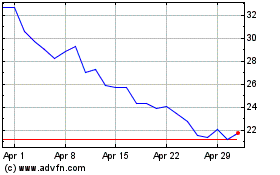
Beam Therapeutics (NASDAQ:BEAM)
Historical Stock Chart
From May 2023 to May 2024
